 United States of America (1941)
United States of America (1941)
Medium Tank – ~49,234 Built
Quantity and quality
The M4 Sherman (named after the famous American Civil War general William T. Sherman) is one of the few really iconic fighting vehicles of the Allies during World War Two, and one of the most famous tanks in history. But while this historic status was gained partly thanks to its intrinsic qualities, but also due to the sheer numbers in which they were provided, only surpassed by the Soviet Union’s T-34, with a staggering 50,000 total delivered. It remains by far the most widely used tank on the Allied side during the war. It was derived into countless derivatives and had a very long postwar career which lasted well into the Cold War. It has been largely compared to the T-34, and had the occasion to confront some during the Korean War.
Hello, dear reader! This article is quite old and scheduled for careful proofreading and re-editing. If you spot anything out of place, please let us know!
However, the Sherman was not as successful as it seemed. Derived in a haste from the previous and controversial M3 Lee/Grant, it was the first to bear a fully-traversing turret with a 75 mm (2.95 in) gun. It was designed from the very beginning for mass-production. Cheap and relatively simple to build, easy to maintain, reliable, roomy, sturdy, fast, well-armored and well-armed, it was the good-all-around armored vehicle the Allies had sought for until 1942, when it first arrived on the North African front.
It literally soldiered in every corner of the globe, under many colors, from 1942 to the end of the war. These theaters included (in WWII alone) most of North Africa, Russia, most of Europe, the Eastern Indies, the Philippines, many Pacific islands and China.
Genesis and context until 1940
By 1940, Great Britain had found itself desperately short on tanks. Some were provided through the freshly signed Lend-Lease agreement. At the same time, the US Army, fully learning from the shock caused by the Blitzkrieg in Western Europe, was in the process of emergency modernization of its equipment. The M4 was, in fact, the type of medium tank the US industry was not yet prepared to build in early 1940, which led to the intermediate M3 Lee. The latter was to be equipped with a fully revolving turret at first, but the urge in production imposed the choice of a transitional, yet unsatisfactory solution, a 75 mm (2.95 in) gun in a hull sponson. So, by late August 1940, as the M3 production started, work was started on the T6 Medium Tank, the prototype of what would become the Sherman.
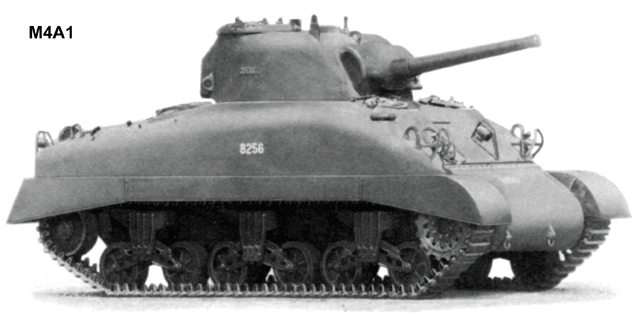
Design of the M4 Sherman
Just like the M3 Lee, the Sherman’s suspension was of the VVSS (Vertical Volute Spring Suspension) type. The running gear comprised three sets of bogies, each with two paired large rubber-covered roadwheels, a rear adjustable track idler wheel and front drive sprocket connected to the gearbox, and three return rollers. The 78-links track was of the standard model, first used on the M1 Combat Car back in 1937, although reinforced and modified to minimize ground pressure.
The Continental R975 engine was an air-cooled, gasoline radial engine delivering 400 hp (298 kW) at 2400 rpm. It was fed by two tanks totaling 660 l (175 gal) of gasoline, which gave around 195 km of practical range (about 120 miles). The power-to-weight ratio was 15.8 hp/ton (11.78 kW/ton). The gearbox was spicer, manual, synchromesh, with 5 forward gears (plus overdrive), one reverse. The controlled differential comprised a built-in brake steering system, which was controlled by levers. There was also a parking brake. The engine compartment contained two fixed large fire extinguishers, manned by a crewmember from the fighting compartment. An auxiliary generator provided extra power and helped warm the engine during cold winters.
The lower hull was made of large welded parts, although the bogies were bolted to the hull for easier replacement or repair, and the rounded front was made of three bolted steel plates. Other external parts were either bolted or welded. The upper hull, at first cast, was later welded, with a well-sloped glacis, flat sides and slightly sloped engine compartment roof, making a characteristic tumblehome culminating just below the main turret. The back plating included a rear “U” shaped exhaust muffler, distinctive of the early production versions. The armor was 76 mm (3 in) thick on the nose and upper glacis, 51 mm (2 in) on the turret and upper sides and 30 mm (1.18 in) elsewhere. The upper hull, at first welded, was cast and rounded on the M4A1.
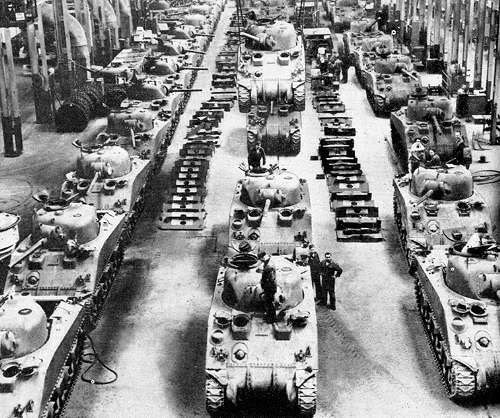
The driver sat on the left of the front of the hull, while the driver assistant sat on the right, firing a ball mounted cal.30 (7.62 mm) machine-gun. The main turret was roomy, enough for the three other crew members. The loader sat on the left of the main gun and the gunner on the right, while the commander was at the rear, just behind the gunner. The three seats had adjustable mountings and could move 30.4 cm (12 in) up and down and 12.6 cm (5 in) forward and backward. The crew had two portable fire extinguishers, a 2-way radio and the use of an interphone.
Access and evacuation could be performed through four hatches. Two above the frontal glacis, one revolving on top of the turret and one on the floor, just behind the driver’s seat. Peripheral vision was excellent thanks to five pericopes (one for each crew member), with a 360 degree traverse and vertical tilting. The turret, cast in one piece, comprised a large “basket” which helped turn the entire fighting compartment with it, revolving on a rail thanks to a Bendix electric system.
On early models, direct vision slits, protected by thick bulletproof glass and hinged covers, were provided to the driver and assistant, but later eliminated due to wartime experience of bullet splashes. The gunner periscope contained a telescopic sight directly synchronized with the main gun, while the gun itself received a gyrostabilization hydraulic system for more accurate firing while on the move. The gunner aimed the gun with a hand wheel and fired through electronic impulse from foot operated switches.
The main gun was a 75 mm (2.95 in) M3 L/40 model, provided with 90 rounds, at first protected by a Combination Gun Mount M34 and coupled with a fixed secondary cal.30 (7.62 mm) Browning M1919A4 machine gun. Both machine-guns (coaxial and hull) received a total of 4750 rounds in cartridge bands, with some tracers. Later models received the new M34A full mantlet, which also protected the machine-gun port. Anti-air and anti-personal defense was provided by the turret roof cal.50 (12.7 mm) Browning heavy machine gun, provided with 400 rounds. The main gun had elevation and azimuth control and FM radio liaison with an artillery center for stationary gunnery support. The M4 was rugged and could endure a 2500 miles (4000 km) run before requiring any form of maintenance. This was particularly appreciated in many emergency situations, notably Patton’s famous “wild rides”, reminiscent of the Blitzkrieg throughout Europe.
Production of the M4
The first factory which delivered the M4 was the Lima Locomotive Works. All of these first batches were sent to the British Army through Lend-Lease, and fought in Africa. They found themselves instrumental in many operations which turned the tide of the war in this sector in favor of the Allies. At first, production rate was of 1000 M4s a month, but rose quickly as more factories were involved (11 total), to a figure of 2000 each month by mid-1942. These included (for all variants) Pressed Steel Cars Co., Pacific Car & Foundry, Baldwin Locomotive Works, American Locomotive Co., Pullman Car, Chrysler’s Detroit Tank Arsenal, Pullman Standard Car Manufacturing Co., Federal Welder, Fisher and Grand Blanc in Michigan, the last being specially built for the purpose during the war.
A total of 6748 M4s (from July 1942 to January 1944) were produced, as well as 1641 of the late variant equipped with a 105 mm (4.13 in) howitzer for infantry support, the M4(105). Early models had the three-piece bolted nose, while later models had a mixed cast/rolled hull. The gun mantlet also evolved from the M34 to the more protective M34A.
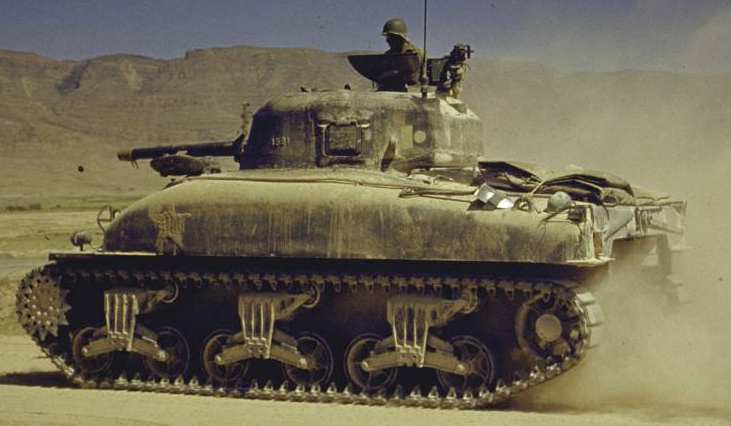
The M4A1 (British Sherman Mk.II)
This first major version was introduced early on in February 1942. It had a fully cast, rounded upper hull. Production of the regular M4A1 totaled 6281 machines until December 1943, but it was replaced by the M4A1(76)W, which received a more recent 76 mm (2.99 in) M1 main gun. 3396 of these improved models were built until March 1945.
The regular “short” M3 L/40 gave a 731 m/s (2400 ft/s) muzzle velocity. But the most efficient was the 1943 model 76 mm (3 in) M1 & M1A1 L/55, which had a 792 to 1036 m/s (2600 to 3400 ft/s) muzzle velocity with the HVAP ammo, being capable of piercing an 100 mm (3.94 in) steel plate at 450 m (1476 ft). The maximum range was 14 km (8.69 mi). Following a painful war experience, the ammo racks and fuel tanks were protected by watery jackets. The commander cupola was also new, featuring 6 prismatic vision blocks 76 mm (3 inches) thick with laminated bullet-proof glass. The engine was the modernized Continental R975-C1.
The M4A2 (British Sherman Mk.III)
M4A2 and M4A2(75)W
This evolution came in April 1942, with a new General Motors 6046 engine (two GM 6-71 General Motors Diesel engines), welded hull with extra applique armor on the hull sides and gunner position (left side of the turret). It was produced to a total of 8053 until May 1944. Early versions of the M4A2(75), had small hatches and protruding drivers’ and co-drivers’ hoods, a 57-degree glacis and dry ammo stowage bins. The rear hull plate was sloped. A transitional version built by Fisher, the M4A2(75)D, had a one-piece 47-degree glacis, with large hatches, but it still used dry ammo bins and applique armor. This model was also produced with a diesel GM 6046, 410 hp, used mostly by the British and the USMC. The range was 241 km (150 mi) with 641 liters (170 gal) of fuel (consumption was 279 liters/100 km or 120 gal/100 mi), total weight 31.8 tons, with a 1.01 kg/cm³ ground pressure. The hull frontal glacis was 108 mm (4.25 in) thick.
M4A2(76)W
The M4A2(76)W was the upgunned late variant, of which over 3230 will be delivered until May 1945. It was fitted with the modified T23 turret, which housed the M1 L/55 gun, which gave an overall length of 7.57 m (25 feet). With the GM 6046 diesel and 673 liters (178 gal) of fuel, the range was 161 km (100 mi). The weight rose to 33.3 tons. The 108 mm (4.25 in) thick glacis was at 47 degrees, with large hatches. By early 1945, the HVSS suspension was fitted.
M4A2E4
Work on this variant of the M4 started in March 1943. The vehicle tested the new independent torsion bar suspension system, which replaced the Sherman’s traditional VVSS suspension. 2 prototypes were produced in the summer of 1943 and tested at the Aberdeen Proving Grounds. The tank borrowed much from the T20E3, another prototype medium tank that would use the same suspension and a 24 inch (0.61 m) wide track. The performance of the suspension on this particular vehicle proved unsatisfactory, and field maintenance too complex. As such, the project was canceled.
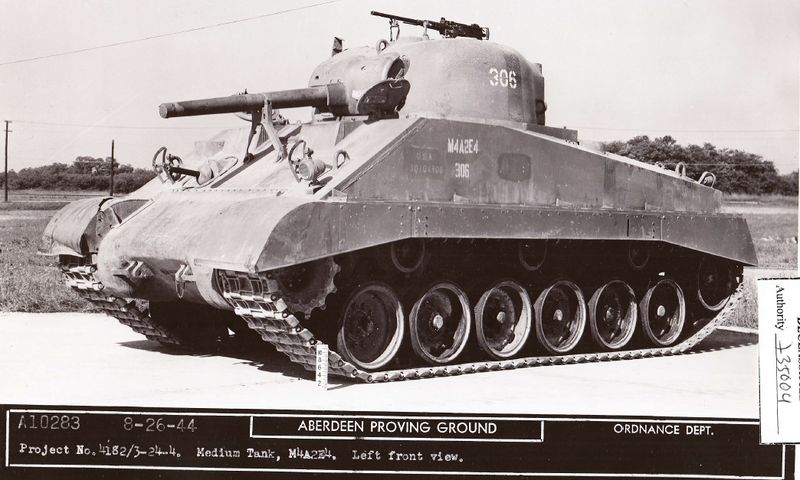
One of the prototype vehicles at the Aberdeen Proving Grounds – Photo: thearmoredpatrol.com
The M4A3 (British Sherman Mk.IV)
M4A3
The M4A3 was first delivered by the Ford Motor Company in June 1942, alone delivering 1690 machines by September 1943. It was produced to a total of 5015 by all manufacturers combined. Early versions still had the dry ammunition stowage, direct vision slots for the driver and the 60-degree hull glacis (89 mm/3.5 in). The 3071 next had wet ammo stowage and a newer commander cupola.
Most of all, it featured the new liquid-cooled Ford V8 500 hp engine, which was capable of giving a top speed of 42 km/h on road (26 mph), and a 209 km (130 mi) range. The suspension was the unchanged VVSS, but the transmission was now protected by a one-piece cast steel armored cover. Driver vision slots were augmented by bullet-proof glass and protective covers. Mid-production they also saw the adoption of duckbills, extended end connectors for the tracks, which improved the grip on soft terrains. Early series also saw extra 25 mm (1 in) thick applique armor welded over the ammo storage bins and the turret gunner position, later removed. By 1943-44, the recognition white stars were usually painted black or olive drab in order to mask them to enemy gunners, which used them as an aiming point.
M4A3(75)W
The M4A3(75)W was equipped with the M3 L/40 gun and had wet ammo stowage. Over 3000 were delivered until March 1945. The modification range was similar to the M4A2(75)W.
M4A3(76)W
The 76 mm (3 in) version, the M4A3(76)W was first introduced in March 1944 and a total of 4500 were delivered until April 1945. Modifications range was similar to the M4A2(76)W.
M4A3E2 “Jumbo”
The famous M4A3E2 “Jumbo” was a substantially uparmored M4A3 version that gained wide fame in Europe.
M4A3(76)W HVSS or M4A3E8 “Easy Eight”
A famous derivative, commonly known as the M4A3E8 or “Easy Eight”, first produced by Detroit Arsenal factory, had a 47 degree sloped glacis with large hatches, wet ammo bins, full up-armored sides, new HVSS suspensions, a revised turret with the long 76.2 mm (3 in) gun fitted with a muzzle brake. They were designed on British specs (local denomination “Sherman AY”), and were produced from March 1944 to April 1945, with 4542 units total. Many had upper side skirt protection.
They were fast, with the Ford V8 500 hp, giving a maximum 47 km/h (29.2 mph) speed. The “Easy Eight” had a range of 161 km (100 mi), with a 475 l/100 km (201.94 gal/100 mi) consumption. These saw action in the latest phases of the conflict in Europe and in the Pacific. The “Easy Eight” was retained in service long after the war and saw service in Korea and Vietnam, as well as in many foreign armies.
M4A3E9
In an attempt to address the Sherman’s ever lasting ground pressure issues, the addition of extended end connectors, or ‘duckbills’ on the outside of the tracks were added. The ‘E9’ version took this one step further by adding ‘duckbills’ on the inside edge of the track as well. To achieve this, the bogey trucks were space-out at approximately 4.5 inches from the lower hull. The modification did work, but by this time the wider HVSS track system had become available, and this essentially overshadowed the variant. As such only one vehicle is believed to have existed.
The M4A4 (British Sherman Mk.V)
This series was first introduced in July 1942 and produced until November 1943, to a total of 7499 machines. It had the most resistant welded hull of all the series, despite a downgraded armor (76 mm/3 in glacis), and received a new composite Chrysler multibank engine (made of five car engines) which needed more space (the hull was lengthened by 15 cm/5.9 in) and scrupulous, careful maintenance. This model was not particularly appreciated with US crews and most went to the British and other Allied forces.
The Russians were the most prolific “customers” of this version, but they didn’t like it either, because of the sensitive engine and relatively light armor. The British, Canadian, New Zealanders, Free Polish and Free French all fought in Italy with this model. They also saw service at El Alamein, during the Tunisian campaign, Sicily and Western Europe. But by mid-44, up-armored and up-gunned models gradually replaced them. Losses had been heavy, not only because of enemy fire. The engine rarely caught fire when hit, but caused trouble because of complicated maintenance issues and long or delayed repairs.
The M4A6
This model had a cast front with welded and lengthened sides and was propelled by a diesel Caterpillar D200A radial. A total of only 75 were delivered between October 1943 and February 1944 by Detroit Arsenal.
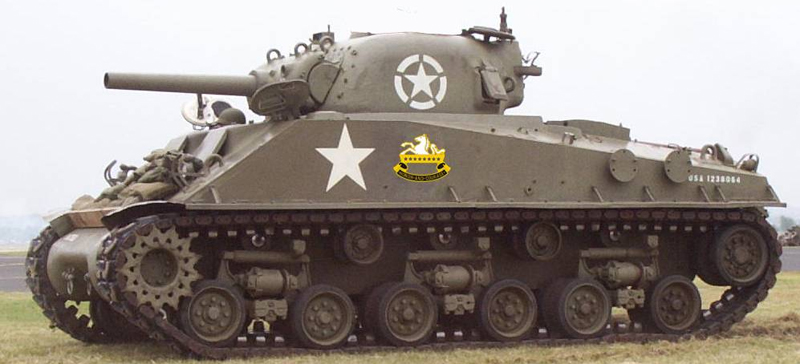
The howitzer version of the Sherman Tank
Most WWII nations had a 75/76mm dual purpose gun (AP+HE) on their main medium tank by 1943-44. However it soon became clear that troops in bunkers or dug-in in rubble would need more explosive power to be destroyed, a 75 mm high explosive (HE) shell is basically only `medium` artillery shell.
Bigger weapons existed but were usually mounted in open topped armoured vehicles – useful for distant radio directed fire but not really suitable for close assault. Sometimes the only way to clear such obstacles was to close in and fire point blank with as larger round as possible. The Russians and Germans went on to increase their high explosive power through mounting 105mm, 122 mm, 150 mm, even 380 mm guns on armoured vehicles. Some of these were fitted in fully superstructures.
To some degree M4/105 mm is similar thinking, the standard Sherman 75 mm has a fair H.E. performance for most applications but a larger gun was needed to deal with enemy fortified positions. It was recognised that a genuine howitzer weapon may lose some AP potential compared to the 75 mm but this did not matter so much.
This was partly due to the specialist requirement of the tank – it`s not really a tank vs tank armoured fighting vehicle (AFV) but more of an infantry support tank. It was the case that for most of the north western European campaign, the US were more commonly in assault mode against an enemy dug in with anti-tank guns and handheld infantry Panzerfausts rather than against hundreds of tanks.
Also the 105 mm weapon now had new A.P. ammunition – high explosive anti-tank (H.E.A.T.). The point about the new ammunition is the muzzle velocity is not so crucial to overall performance. Thus a gun with a short barrel firing low velocity ammunition still has a respectable A.P. performance.
Overall M4/105 out performs standard Sherman 75mm H.E by about 2:1 (or more) while the A.P. potential is about the same and sometimes better (remember its early days for HEAT and it was not yet 100% consistent). The gains in H.E. mode significantly outweigh any possible loss for the A.P. mode. Thus a useful compromise and a powerful addition in close assault mode.
M4(105)
First introduced in February 1944, production of the 105 mm (4.13 in) version stopped in March 1945, after a total of 1641 machines. It was devised during the Italy campaign, to give added infantry support firepower with the advantage of a fully traversing turret. In fact, the M7 Priest was one of the most widely used SPGs during this particular campaign. The standard M1919A4 howitzer was modified and compacted for the task. All existing gun aiming and facilities for indirect fire were improved.
The armor was slightly thinner than usual, ranging from 63 mm (2.48 in) (glacis sloped at 47 degrees), 38 mm (1.5 in) for the sides and rear and 19 mm (0.75 in) for the top. The mantlet was 91 mm (3.58 in) thick, turret front was 76 mm (3 in), slopes were 51 mm (2 in) and top 25 mm (0.98 in). The engine was the early radial Continental R975-C4, 9-cylinder 4-cycle, air cooled (15,945 cc and 460 hp at 2,400 rpm), giving a range of 161 km (100 mi) and a cruise speed of 38.6 km/h (24 mph) on road.
M4A3(105)
Produced from May 1944 to March 1945 with a total of 3039 machines. It had every improvement of the regular A3 series and thus was more successful. It appeared quickly that the punch of a solid HE round was also more than adequate in many tank to tank engagements against German armor. Used in conjunction with “Zippo” (flamethrower) versions, the USMC deployed these support pairs with high profit against Japanese fortifications.
A famous offspring: The Firefly
The famous Sherman Firefly was, in fact, a British project, equipped with the QF 17-pdr (76.2 mm/3 in) gun. More than 2000 were built and served in the European Theater of Operations.
Derivatives
M10 Wolverine Tank Destroyer
The M10 GMC was armed with a 3 in gun (76.2 mm), being the first of the famous trio of US tank destroyers. Over 6700 were built.
M36 Jackson Tank Destroyer
The M36 GMC was armed with a far more powerful 90 mm (3.54 in) gun. 1400 were built and they had a long postwar career.
M7 Priest HMC
The M7 Priest was a self-propelled howitzer using the standard M1/M2 105 mm (4.13 in) howitzer.4443 were built until the end of the war.
Grizzly
The Grizzly was a Canadian version built using US spare parts at the Montreal Locomotives Factory on the M4A1 chassis. 188 were built.
Flame-thrower versions
M4A3R3 Zippo: Probably the most famous of these versions, developed by the USMC to deal with Japanese bunkers, reinforced pillboxes and other fortifications. The name came from the famous lighter. It was developed in 1944 after the terrible casualties at Saipan, and first served en masse at Iwo Jima and later at Okinawa.
M4 Crocodile: British modified M4s along the same lines as the Churchill Crocodile, for the US 2nd Armored Division.
Sherman Badger: An offspring of the Ram Badger, this was a Canadian version of the M4A2 HVSS equipped with a Wasp IIC flamethrower.
Sherman Adder: Local conversions kits developed in India for the Sherman III and V which fought in the Eastern Indies campaign.
Heavy GMC versions
155 mm Gun Motor Carriage M40: This self-propelled gun used the “Long Tom” (155 mm/6.1 in) artillery piece and was assisted by the T30 cargo ammunition carrier.
203 mm Howitzer Motor Carriage M43: This 8-in howitzer version was closely based on the M40.
250 mm Gun Motor Carriage MMC T94: A 10-in GMC also closely based on the M40, probably the heaviest piece of ordnance ever put on a Sherman.
Rocket-launcher versions
T34 Calliope: Famous rocket version, developed in 1944 and massively used against German positions in 1945. Fired up to 60 113 mm (4.45 in) (E1) or 183 mm (7.2 in) (E2) rockets.
T40/M17 Whizbang: A 1944 special demolition version equipped with a set of short-range 7.2″ HE rockets (183 mm).
Sherman Tulip: A handful of Shermans were equipped with two 3-inch (“60 lb”) RP-3 (76.2 mm) rockets on rails on the turret.
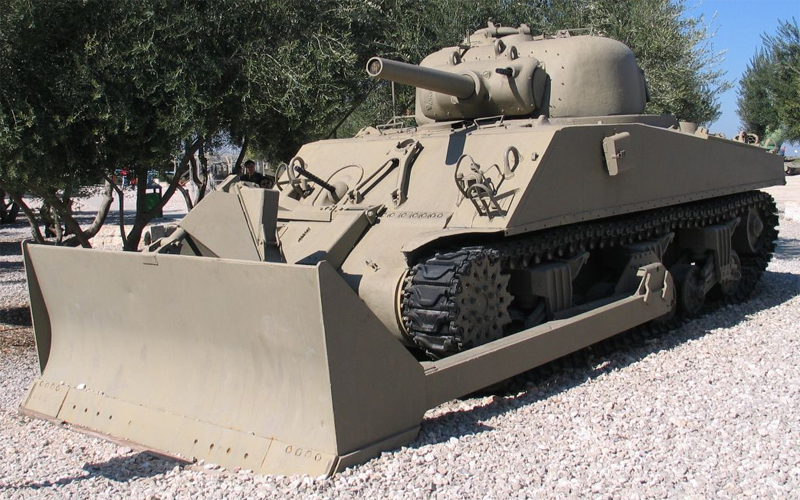
Genie versions
M4 Dozer: M4 fitted, in 1943, with a hydraulic dozer blade from a Caterpillar D8. Widely used in many theaters of war to create airfields and base camps in wooden or jungle areas. First developed as a kit, but later on more turretless Shermans appeared with this equipment fixed permanently. It was largely used in the Normandy Bocage, later replaced by Shermans equipped with the Culin Cutter kit.
M4 Doozit: M4 dozer equipped with demolition charges on a wooden platform. Never used in combat, contrary to the T40 WhizBang.
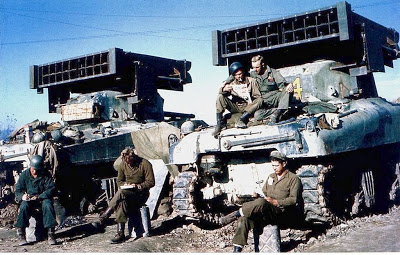
M4 Bridgelayer: Many US and Commonwealth versions. First introduced in Italy as a turretless Sherman equipped with a frame-supported assault bridge with a rear counterweight. There were also the British Fascine carrier Crib, Twaby Ark, Octopus used by the 79th Armoured Division, the Plymouth (Bailey Bridge) and the US Sherman AVRE fitted with a Small Box Girder bridge.
M4 Mine-clearer: No less than 26 variants, some never operational, came to life between 1943-45. First operational ones appeared in Italy. The US-versions (T1-T6 Roller) used two massive front rollers to explode the mines by ground pressure, while the British versions Sherman Crab (T2-T3 and sub-variants) used a frontal flail roller, similar to the Scorpion. The Canadian CIRD (Canadian Indestructible Roller Device) was a land-mine exploder. There were also a serrated edged disc version, mine exploder versions equipped with a frame with small rollers or a steel plunger, several mortar versions, a remote-control demolition version and a plow version with depth control apparatus.
Recovery versions
Sherman ARV: (Armored Recovery Vehicle) Several British versions based on the Sherman III (M4A2) and Sherman V (ARV I and ARV II).
Sherman BARV: Same, but specialized for beach vehicle recovery.
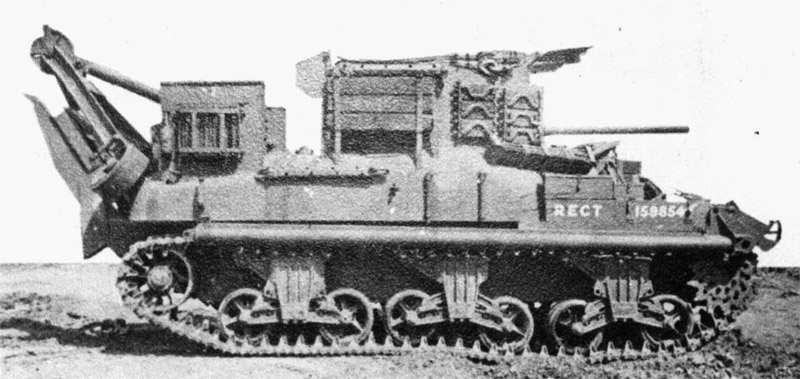
Amphibious versions
Sherman DD: (for “Duplex Drive”, but the crews nicknamed it “Donald Duck”) This special-purpose vehicle was specifically developed for D-Day. It featured a flexible waterproof canvas skirt fixed on the mudguard, reinforced with a folding wooden and metal frame.
The principle was to create some buoyancy through a “flotation screen”, first developed by the British Hungarian-born engineer Nicholas Straussler in 1940. Several trials were performed with various tank models including the Valentine but later applied to the Sherman in the perspective of future amphibious landings. Other modifications included a bladed propeller fitted at the back, which could be activated by the main engine (hence the name of “duplex drive”).
The idea was sound and well-tested during D-Day on June 6, 1944, several hundred British and US DDs, launched from cargo ships 2 miles (3.22 km) from the shore assaulted their respective beach sectors. However, due to the bad weather, many were lost en route to the shore. They had more successes during operation Dragoon (landing in southern France) and when crossing the Rhine by early 1945.
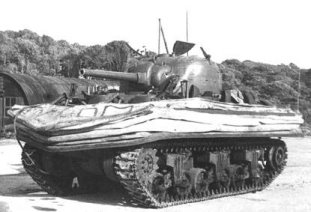
Shermans with T6 devices: This was a kit adapted to a limited number of USMC Shermans during the assault on Okinawa. It consisted of four (for each side) boxy pressed-steel floats, called pontoons, which procured buoyancy, while the tracks provided some propulsion. It was only used close to the shore. The equipment was then removed by the crews for the upcoming operations.
Shermans with Deep Wading Gear: This apparatus consisted of two large ducts mounted on top of the engine ventilation hatch and exhaust. Thanks to this system, which caught air one meter above the tank, and well-sealed hatches, the Sherman could be deposited by large ships on the sea floor, at more than three meters depth. This kit could also be used to ford large rivers. The USMC used some for operations in the Pacific and in Europe, some took part in the assault on Dieppe (1942), at Salerno and during the Normandy landings in 1944.
The Sherman in operations
As General Patton himself summarized: “In mechanical endurance and ease of maintenance our tanks are infinitely superior to any other”. This was especially true compared to the Tigers and Panthers which had a high consumption, requiring careful maintenance and limited cross-bridges capabilities.
The Sherman’s mobility was improved by a favorable power-to-weight ratio. German reports stated that the Sherman could climb slopes at angles thought impossible for any Panzer. Their narrow build also helped them cross narrow streets, bridges and forested areas as well, but most of all, helped transportation by rail, therefore improving their mobility.
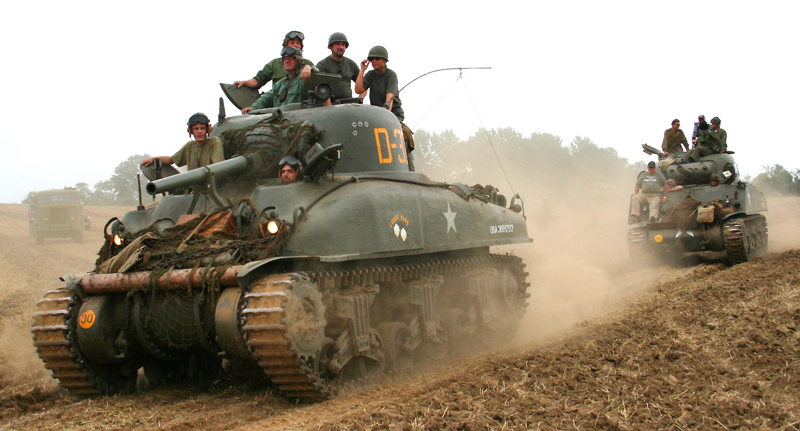
Their high, bulky nose helped them crush thick vegetation easily, and they were found sturdy and powerful enough to go through any kind of house or wall, which helped them in many urban fights, especially in Italy. However, despite their moderate ground pressure, the narrow tracks were judged inadequate on soft terrain, especially mud and snow. A partial response was found in the adoption of extra track parts known as “Grousers” or “Duckbills”. This feature was factory-born to help the M4A3E2 Jumbo reduce ground pressure. It became mandatory in the “Easy Eight” as well, and these improved tracks were also fitted on some late types by 1945.
The standard VVSS suspension was also the object of some criticism, openly compared to the far more refined torsion arm system used by the Panther, which allowed a very smooth ride and more accurate fire on the move. The solution came in late 1944 with the adoption of the improved HVSS (Horizontal Volute Spring System). The basic system was not changed, but it secured a smoother ride and a better weight distribution, which helped to stabilize the tank.
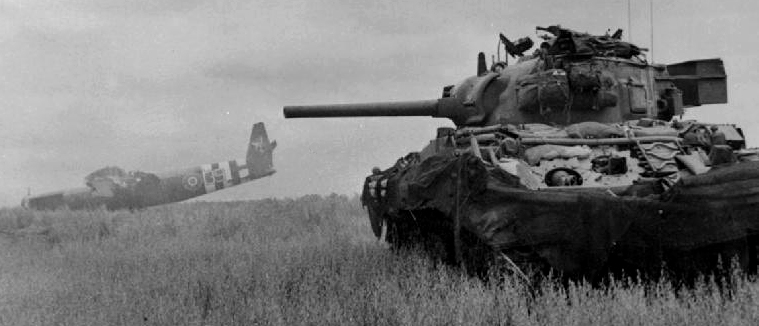
Large-scale production and a limited weight (which never really exceeded 36 tons except for a few machines, the average weight being 31-33 tons) helped the large-scale transatlantic shipping of these, despite U-Boot losses. This allowed overall superiority in numbers on the battlefield. Training required few hours and M3 Lee veteran drivers and even gunners had no problems operating the Sherman, thanks to a high level of standardization. For infantry support, the Sherman looked ideally suited.
Dominating the terrain, the commander had an excellent view and the infantry, advancing behind, was well-protected. Two cal.30 (7.62 mm) machine-guns fired in a “blind mode”, just producing a volume of fire, especially into the Normandy hedgerow and thick vegetation areas in general. But the heavy cal.50 Browning 12.7 mm was even more powerful, efficient against all kind of fixed targets: brick walls, wooden structures, metal pillboxes, even concrete, and could destroy most of the German prime movers and vehicles, even the armored “Hanomag”. It could be also lethal, with some luck, against low-flying aircraft. Its downside was the completely exposed position of the machine gunner, as he had to sit on the rear deck of the tank to use it.
However, the M4 losses during the war reflect the “dark side” of this story. On every front, single tank-to-tank engagements against German tanks turned to be generally unfair, especially with the early versions. The 76 mm (3 in) frontal glacis just couldn’t stop the most recent German AT guns, not to mention the sides, just 50 mm (1.97 in) thick. The hull, due to the high transmission (required by the radial engine) towered at nearly 3 meters (9.84 ft) above the ground, twice the height of the most common German AFV, the StuG III.
Post-war, the Sherman tank gained an unfounded reputation for catching fire easily which still endures. For a tank which in later versions had wet ammo storage and extra protection for ammunition this reputation was meaningless, but nevertheless, it endures long after the Normandy campaign.
In Normandy, many Shermans were also killed because of well-hidden and camouflaged AT guns and tanks, helped by the bocage configuration. A partial solution was given by the use of a Culin hedgerow cutter fitted to the lead tank of a company, which was usually also the first one to be killed in action.
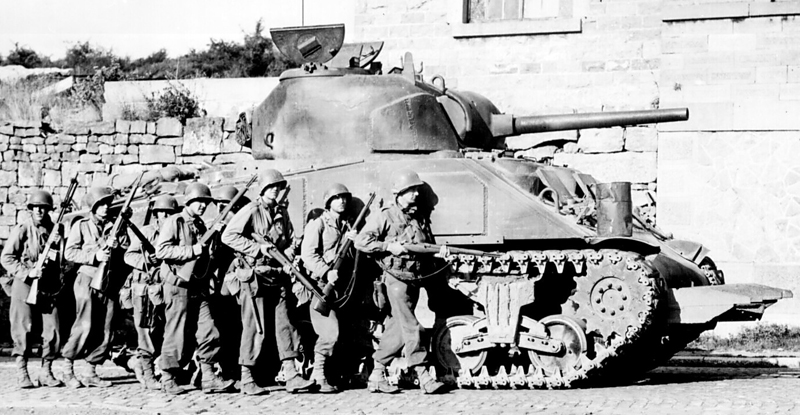
The Sherman design evolution dictated by wartime experience called for a thickening of the glacis and side armor, from 76 to 89 mm (3 to 3.5 in), then 108 (4.25 in) and finally 178 mm (7 in) on the “Jumbo”. The Jumbos were usually used as leading tanks. Shell-proof, they spotted the enemy and helped out-flanking maneuvers. However, the “Easy Eight” and “Firefly” rarely led companies, but instead, they were called when the enemy was spotted, using their high-velocity gun to terminate the threat. The British and Canadian versions also camouflaged their long 76.2 mm (3 in/17-pdr) barrel to appear just the length of a standard 75 mm gun and trick enemy spotters which had to choose their targets.

M4A1(76) “In the Mood II”, American tank ace Lafayette G. Pool, Operation Cobra Normandy July 1944
Additional armor plate was often welded in front of the driver and co/driver’s position at the front of the tank and at the side to give them greater protection. The armor plate at the front was 1 1/2 inches (38.1mm) thick and only welded at the top and bottom at an angle leaving a gap in between. This was a form of early spaced armor.
Armor issues led many crews to come up with some sort of impromptu protection made in the field of whatever available, namely sandbags, spare track links, concrete, wire mesh and wood, notably against shaped charge rounds (Panzerfaust and Panzerschreck). General Patton ordered a study of the practice of adding loads of sandbags, ordering some systematic tests, which proved that only in a few particular angles the shaped charge of a Panzerfaust failed to penetrate the armor. Therefore, as this practice both stressed the chassis and overheated the engine, it was soon forbidden. Such modifications were also highly common in the Pacific Theater, in order to protect from Japanese infantry attacks with grenades and mines.
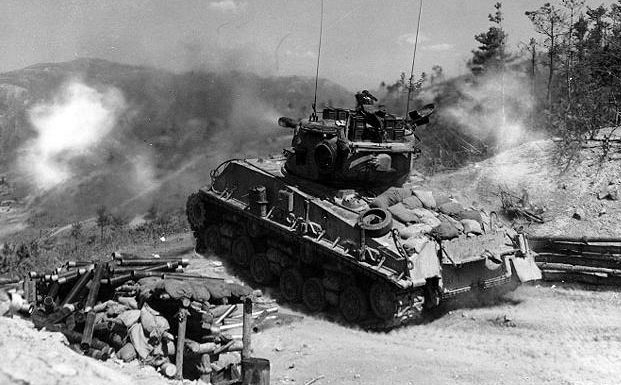
Cold war career and memorabilia
Despite being designed in 1941, the Sherman was still in service in many countries as far as the fall of the iron curtain in 1990, leaving the strange impression of a “living fossil”. This could be found in the many improvements performed on its chassis, a testimony to its sturdiness and adaptability, and the huge supplies of spare parts available due to an early standardization and unrivaled, at least in the West, mass production. The “Easy Eight” was the blueprint for some improvements and late wartime versions that fought under the US flag during the Korean war and later the Vietnam war, under South Vietnamese flag. The Israeli completely modernized the type, later known as the M51 “Super Sherman”, which performed well during the 1967 and 1973 wars, armed with a new 105 mm (4.13 in) high velocity gun.
M4 Sherman specifications |
|
| Dimensions | 5.84 x 2.62 x 2.74 m 19’2” x 8’7” x 9′ |
| Total weight, battle ready | 30.3 tons (66,800 lbs) |
| Crew | 5 (commander, driver, co-driver, gunner, loader) |
| Propulsion | Continental R975 9-cyl. air-cooled gasoline, 400 hp (298 kW) |
| Maximum speed | 48 km/h (30 mph) on road |
| Suspensions | Vertical Volute Spring (VVSS) |
| Range | 193 km (120 mi) |
| Armament | M2 L/32 or M3 L/40 75 mm (2.95 in) with 90 rounds 2xBrowning M2HB cal.30 M1919 (7.62 mm) machine-guns |
| Armor | Maximum 76 mm (3 in) |
Gallery
Links & Resources about the M4 Sherman
The M4 Sherman (Main Wikipedia article)
The M4 on WWIIVehicles
The M4 Sherman on globalsecurity.org
Complementary data about the M4 on afvdb.50megs.com
Fine large scale M4 photos on the Shadock
A highly comprehensive list of Sherman books & reviews -modeler friendly
Sherman Minutia, tech database (the shadocks)
Variants
 US variants
US variants
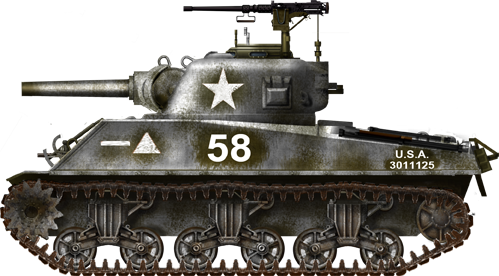
M4A3(105), Company H, 69th Tank Battalion, 6th Armored Division, Ardennes, December 1944.
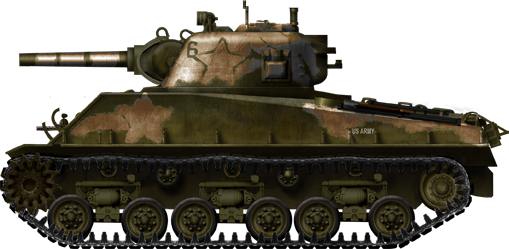
M4A3(105) Sherman, 713th Tank Battalion, Okinawa, 1945.
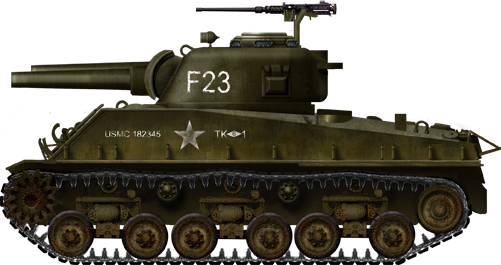
M4A3R2 “Zippo”, late version HVSS, flamethrower variant developed by the USMC, here deployed at Okinawa, in support to the 1st Marine Division, May 1945.

M4 Sherman Crab, Normandy, June 1944.
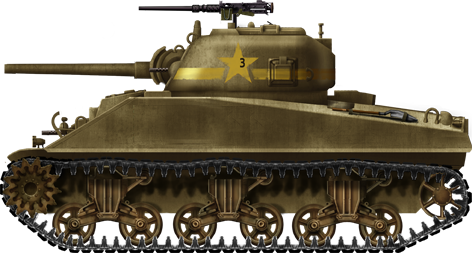
M4, early production version (1942), 13th Armored Regiment of the 1st Armored Division, Tunisia, March 1943. One of the rare Shermans actually painted sand beige in US Service.
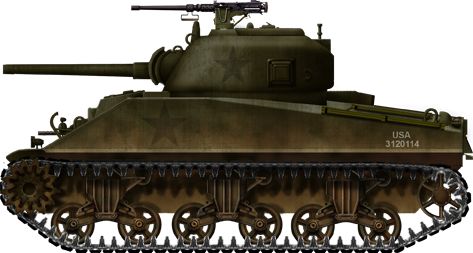
M4 Sherman, early production vehicle, 32nd Tank Battalion of the 3rd Armored Division, Normandy, 1944. Notice the “low visibility” stars.
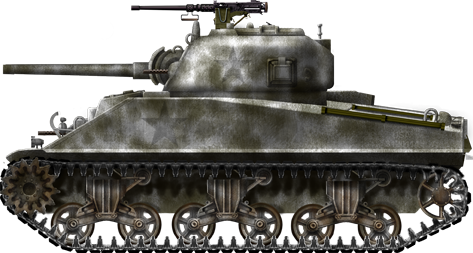
Early production M4 Sherman, 40th Tank Battalion, 8th Armored Division, Belgium, February 1945, at the end of the battle of the Bulge.
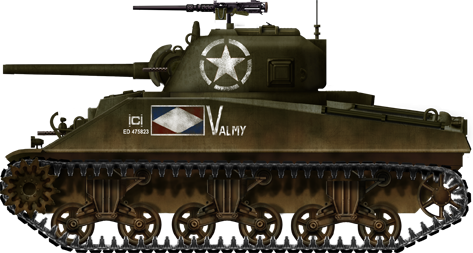
M4 Sherman, 2nd Armored Division, 1st Free French Army, Operation Anvil Dragoon, Provence, August 1944.
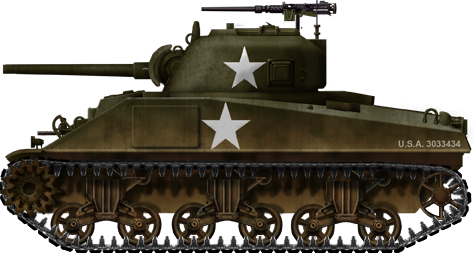
Early type M4, unknown unit, Normandy, summer 1944.
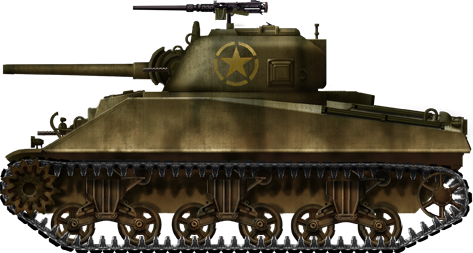
M4 Sherman, mid-production version (1943), of the 756th Tank Batallion, 5th Army, Monte Cassino sector, February 1944.
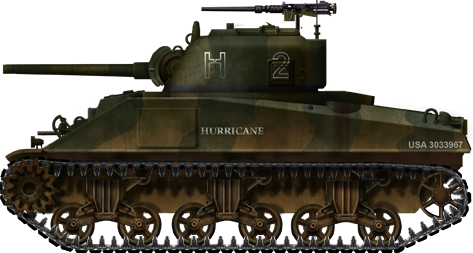
M4 Sherman “Hurricane”, H Company, 66th Armored Regiment, 2nd U.S. Armored Division, Normandy, June 1944.
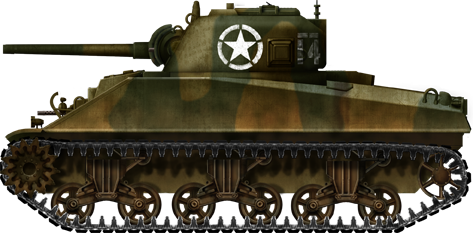
C company, 756th Tank Battalion, 5th Army, Italy, February 1944.
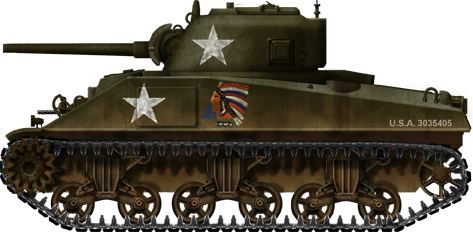
37th Tank Battalion, 4th U.S. Armored Division, Brittany, France, July 1944.
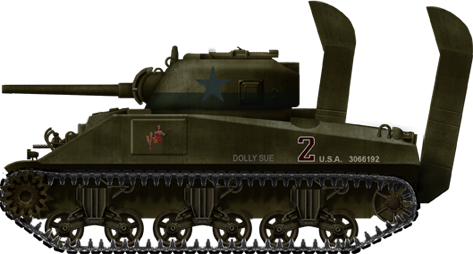
Sherman DWG (Deep Wading Gear), C company, 70th Tank Battalion, Utah Beach, Normandy on D-Day.
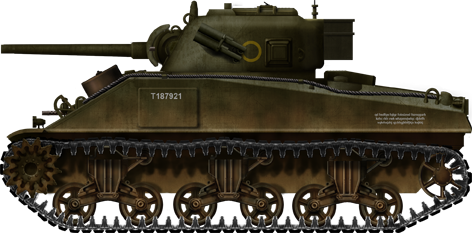
Sherman Mk.I of the 27th Staffordshire Yeomanry Armoured Brigade, C squadron, Second Regiment, Normandy, summer 44.
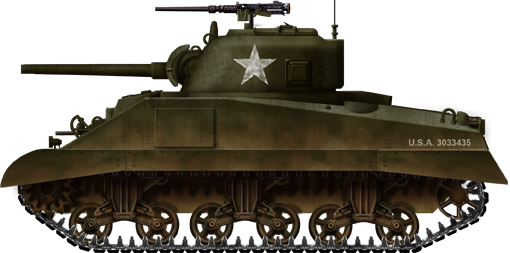
M4 with side skirts, unknown unit, Operation Cobra, Normandy, July 1944.
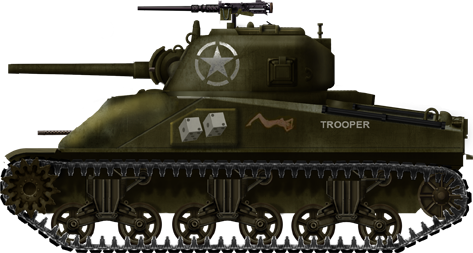
M4 with a composite hull, 175th Tank Battalion, 123rd Regiment, 33rd Infantry Division, Leyte, Philippines invasion, March 1945.
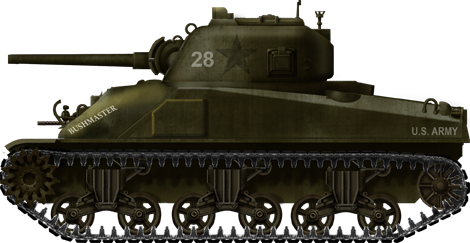
M4, composite hull, “Bushmaster” of the 763rd Tank Battalion, 96th Infantry Division, Leyte island, Philippines, fall 1945.
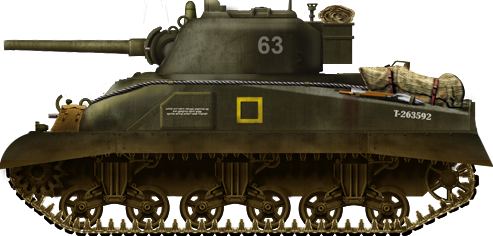
Sherman Mk.I Hybrid (composite hull) of the 144th RAC, Italy, March 1944.
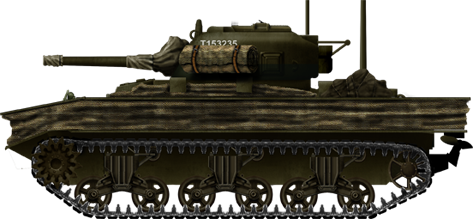
Sherman DD (Duplex Drive), 743rd Tank Battalion, Omaha Beach, Normandy, D-Day.
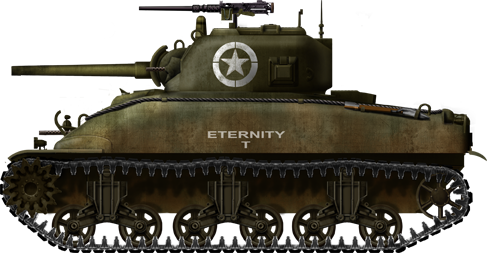
Sherman M4A1, early production variant, Operation Husky, Sicily, July 1943.
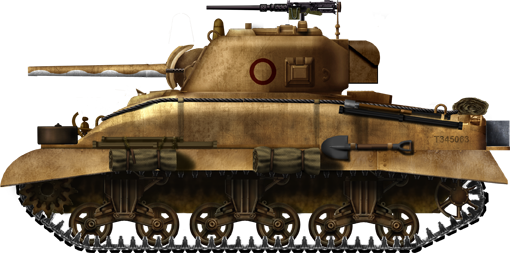
Sherman Mk.II, 3rd The King’s Own Hussars, 5th Armoured Brigade, VIIIth Army, Egypt, September 1942.
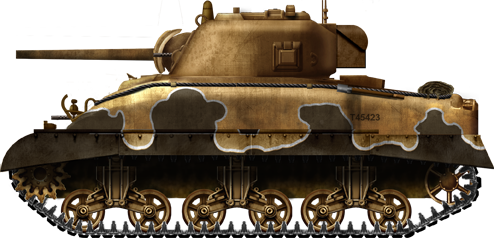
Sherman Mk.II early type, HQ, 3rd Armored Brigade, El Alamein, October 1942.
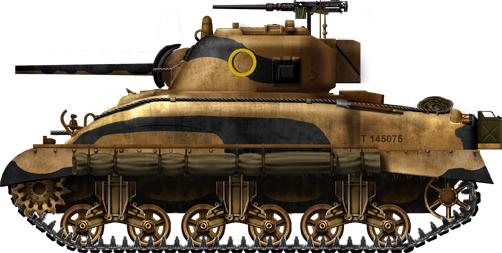
Sherman Mk.II, 9th Queen’s Royal Lancers, 2nd Armoured Brigade, 1st Division, Egypt, November 1942.
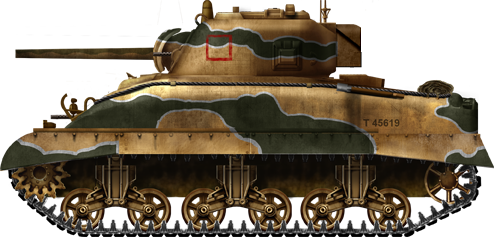
Sherman Mk.II early type from the 3rd Armored Brigade, El Alamein, October 1942.
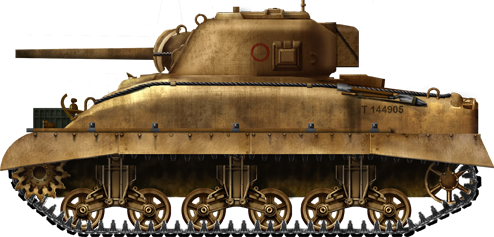
Sherman Mk.II (Direct Vision Type), C squadron, 3rd Hussars, 9th Armoured Brigade, 2nd New Zealand Division, El Alamein, November 1942.
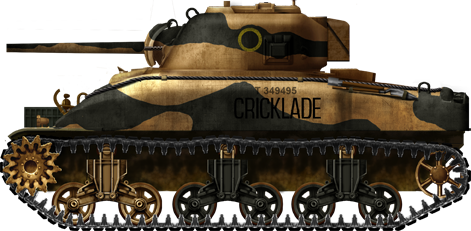
Sherman Mk.III late type, C Squadron, Royal Wiltshire Yeomanry, El Alamein, November 1942.
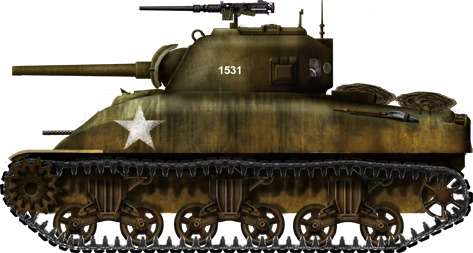
M4A1 mid-production vehicle, U.S. 1st Armored Division, “Henson Force”, Battle of El Guettar, Tunisia, March 1943.
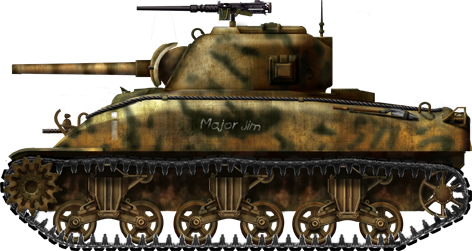
M4A1 mid-production, “Major Jim”, 2nd Battalion, 13th Armored Regiment, 1st Armored Division, Kasserine pass, February 1943.
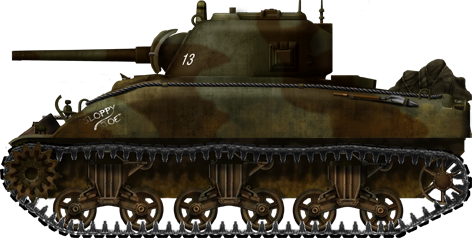
M4A1 mid-production, 603rd Armored Regiment of the 41st Infantry Division, Carolines Islands, Pacific, late 1944.
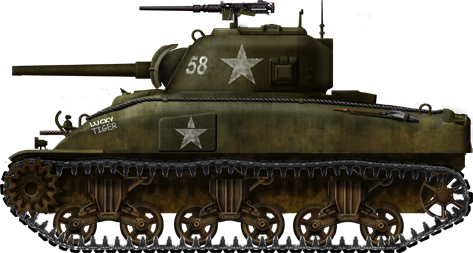
M4A1 late production, 7th Infantry Division, Ebeye Island, Pacific, part of the Kwajalein Atoll, Marshall Islands, January-February 1944.
W_11TB_10AD_Ardennes.png)
Sherman M4A1(76)W, 11th Tank Battalion of the 10th Armored Division, Ardennes, January 1945.
W_HVSS.png)
Sherman M4A1(76)W HVSS (Horizontal Volute Spring Suspension), Western Germany, March 1945.
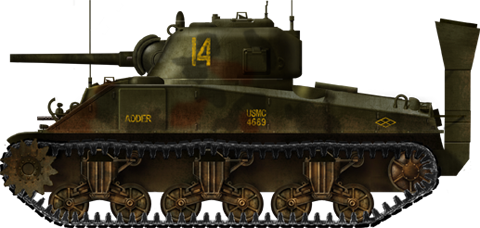
M4A2 (mid production) “Adder”, A company, 3rd USMC Tank Battalion, Iwo Jima, March 1945.
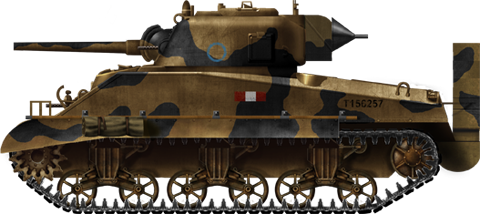
Sherman Mk.III, 3rd County of London Yeomanry (3rd CLY), Italy, Winter line sector, fall 1943.
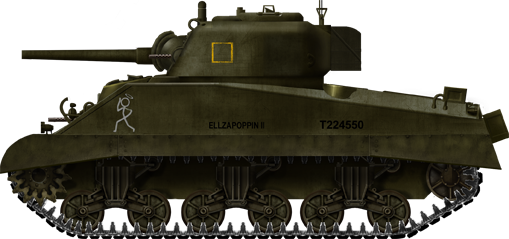
Sherman III “Ellza Poppin II”, 48th Royal Tank Regiment, Anzio, 1944.
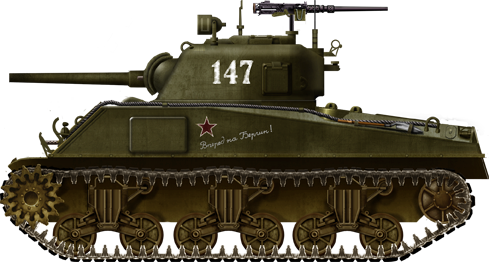
Russian M4A2 (late production), with the 47-degree slope and an added 108 mm (4.25 in) of frontal armor. Northern Front, fall 1943. Around 2000 M4s were delivered at Arkhangelsk. Most were M4A2s, which were immediately put to use on the Northern Front. Those delivered through the “Persian Corridor” saw action in the Taman peninsula and in Northern Caucasus from early 1943.
W_russian.png)
Russian M4A2(75)W of the 46th Armored Brigade, 1st Armored Division, Northern Front, winter 1943-44.
.png)
Panzerkampfwagen M4-748(a), captured Sherman in German service, from an unidentified unit in Italy, 1944. Due to their appearance and the fact that few disabled Shermans were left in a repairable condition, perhaps less than twenty Shermans of all versions were ever used in German service, although clear evidence shows this occurred in Tunisia, Italy and during the Battle of the Bulge.
W_Russian_1.png)
M4A2(76)W, early type, in Russian service with duckbills, Northern Front, Eastern Prussia, late 1944. Slogan: “To Berlin!”.
W_late_Russian.png)
M4A2(76)W, late type with duckbills in Russian service, Battle of Berlin, May 1945.
W_HVSS_Germany45.png)
Sherman M4A2(76)W HVSS of Patton\’s U.S. 2nd Armored Division, Western Germany, March 1945.
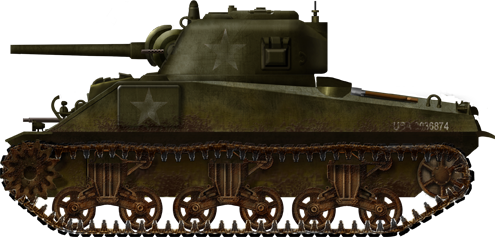
M4A3 early type, 3rd Armored Division, Normandy, June 1944.
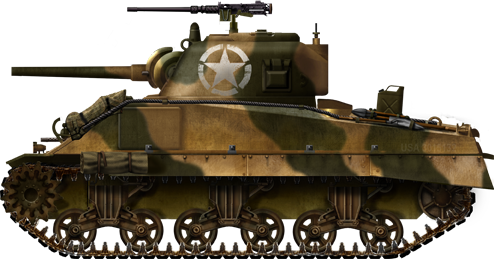
Sherman M4A3 early type, 1st Armored Division, liberation of Rome, June 1944.
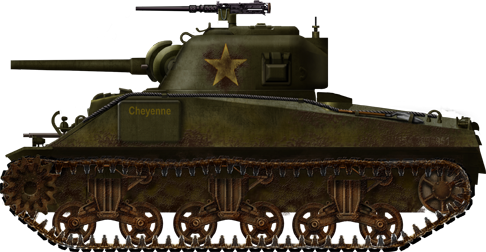
Sherman M4A3 mid-production “Cheyenne”, 2nd Armored Divison, Normandy, June 1944.
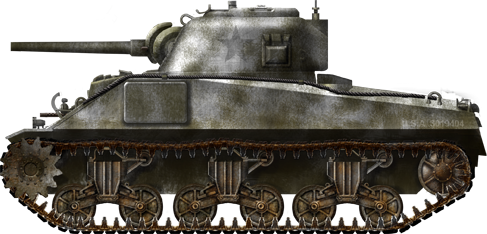
M4A3 mid-production vehicle with late train type, 11th Armored Division, in support of the 30th U.S. Infantry Division, Ardennes, Belgium, January 1945.
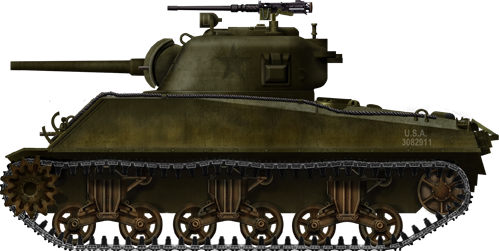
Sherman M4A3(75)W (equipped with duckbills and metal track links) of the 4th Armored Division, 3rd US Army, battle of Nancy, September 1944.
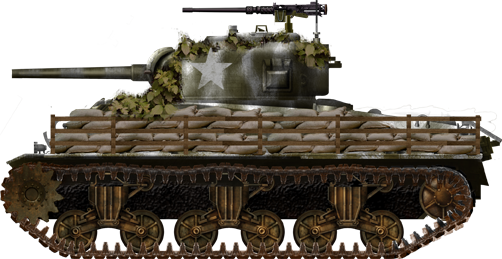
An up-armored M4A3 in the Ardennes, January 1945. Because of the lack of protection offered by the early versions, experienced crews took the matter into their own hands and usually applied improvised protective measures in the field. Wooden planks, beams, rails, steel plates, spare track links and improvised cofferdams made of wood and sandbags, like seen here, were some of the solutions found. The engine could not keep up with the extra load, and, after an inquiry following an unusual rate of breakdowns and high consumption figures, Patton forbade tank crews from such practices.
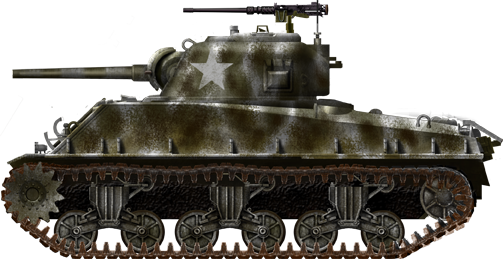
M4A3 late production vehicle with an improvised camouflage made of regular washable white paint and mud spots, South-Western Germany, March 1945.
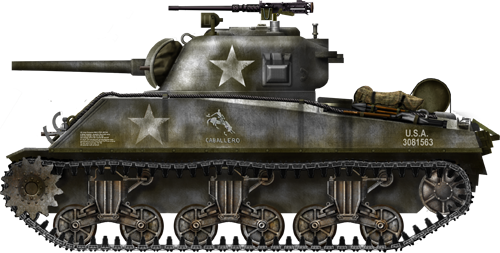
M4A3(75)W of the 6th Armored Division, Ardennes, Belgium, January 1945.
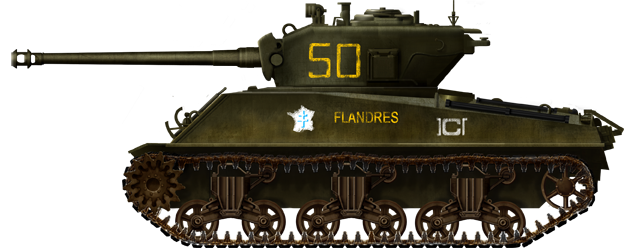
M4A3(76)W from the 12th African Light Infantry Regiment (1st French Army), Vosges area, fall 1944.
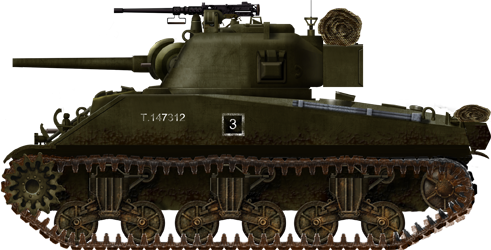
Sherman V (M4A4) of the 2nd Armored Brigade, Irish Guards, Operation Goodwood, June 1944.
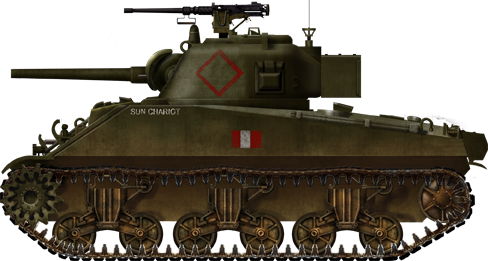
Sherman V of another unidentified Irish unit, Operation Goodwood, Normandy, June 1944.
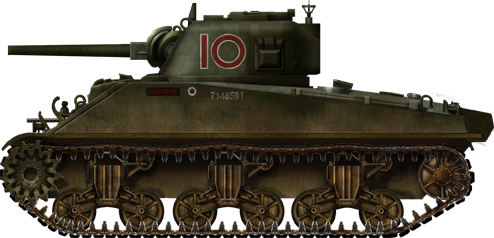
M4A4 (Sherman V) of the RHQ 13/18th Royal Hussars, Normandy, June 1944.
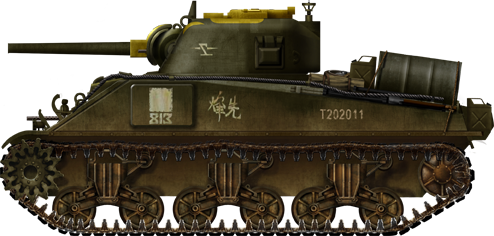
Chinese M4A4 from the 1st Provisional Tank Group, Burma, 1945.
w.png)
M4A3(76)W HVSS of the 41st Tank Battalion, 11th Armored Division, 3rd US Army, Rhine western banks, February 1945
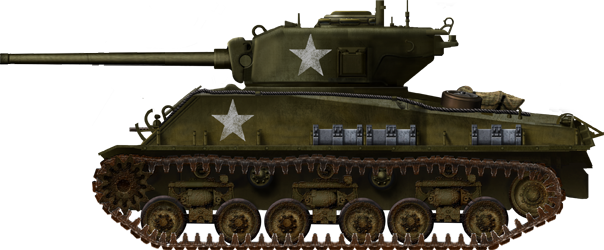
M4A3E8 “Easy Eight”, the last evolution of the Sherman, Southern Germany, May 1945.
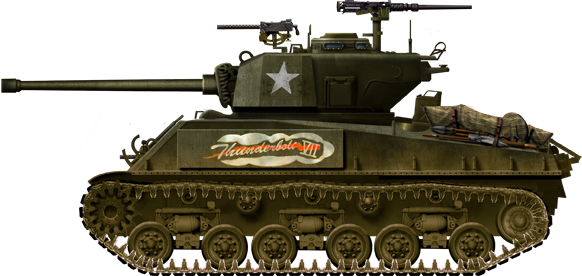
Colonel Creighton Abrams’ “Thunderbolt VII” and his famous personal insignia, Horazdovice, May 1945.
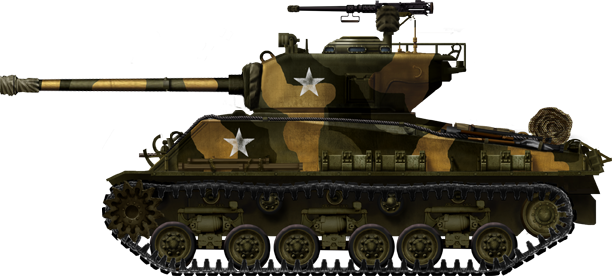
M4A3E8 in Korea, 1951.
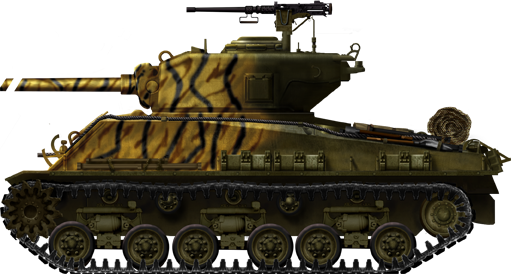
South Korean Easy Eight in 1952 with the famous “Tiger Pattern”.
“Tank-It” Shirt
Chill with this cool Sherman shirt. A portion of the proceeds from this purchase will support Tank Encyclopedia, a military history research project.
American M4 Sherman Tank – Tank Encyclopedia Support Shirt
Give ’em a pounding with your Sherman coming through! A portion of the proceeds from this purchase will support Tank Encyclopedia, a military history research project.
By David Lister
A compilation of little known military history from the 20th century. Including tales of dashing heroes, astounding feats of valour, sheer outrageous luck and the experiences of the average soldier.

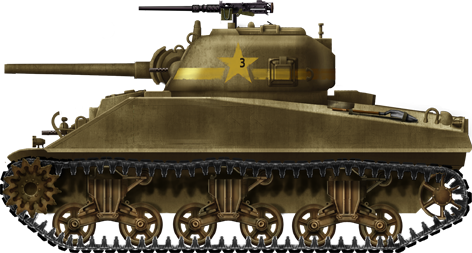
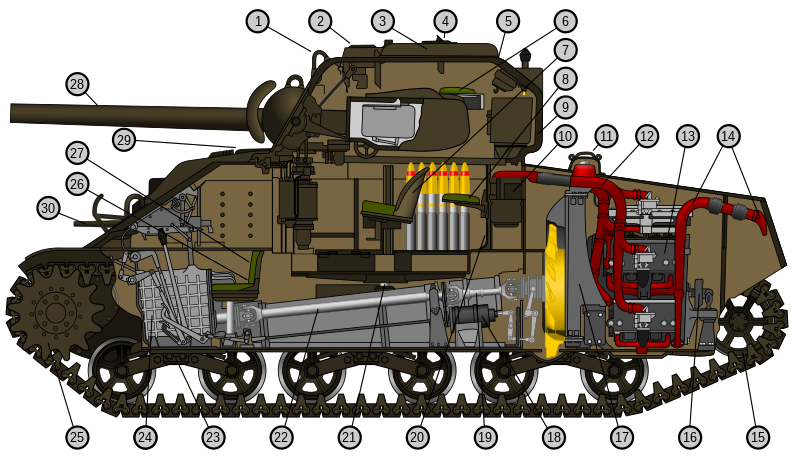


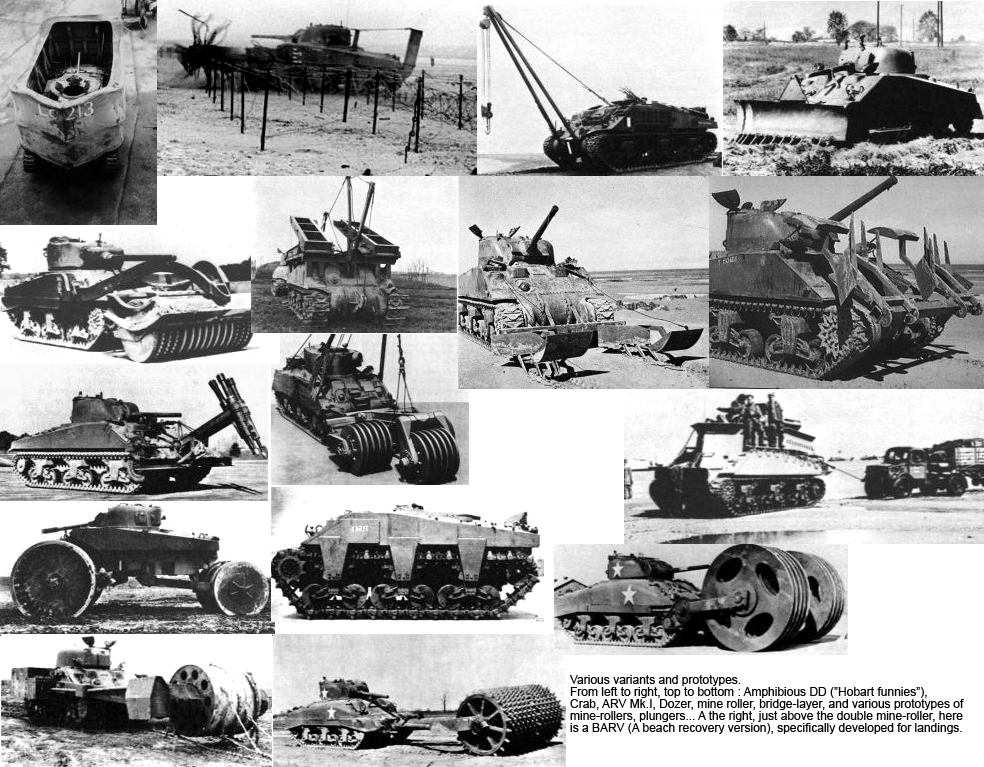
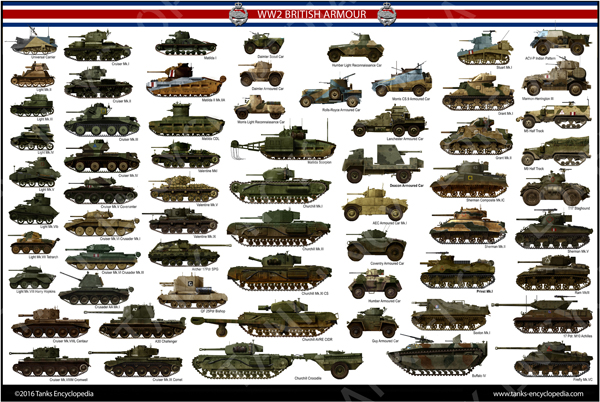
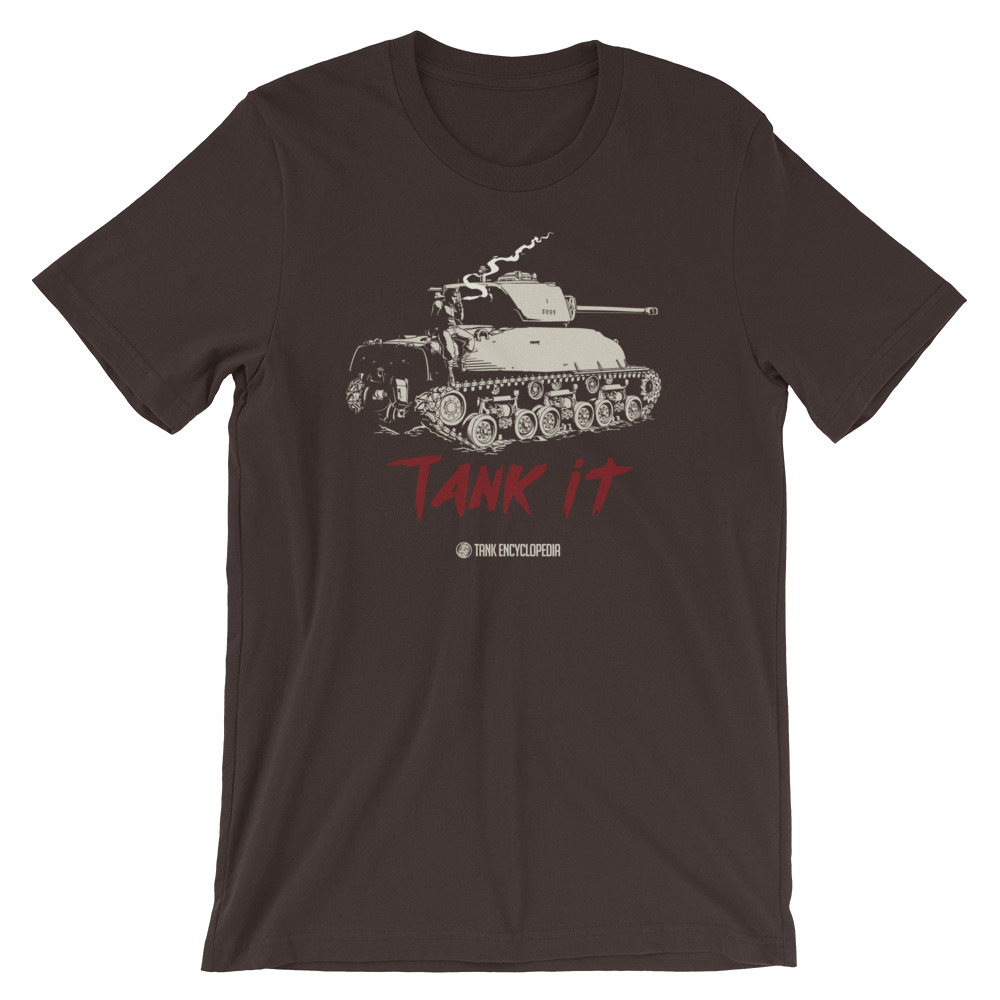
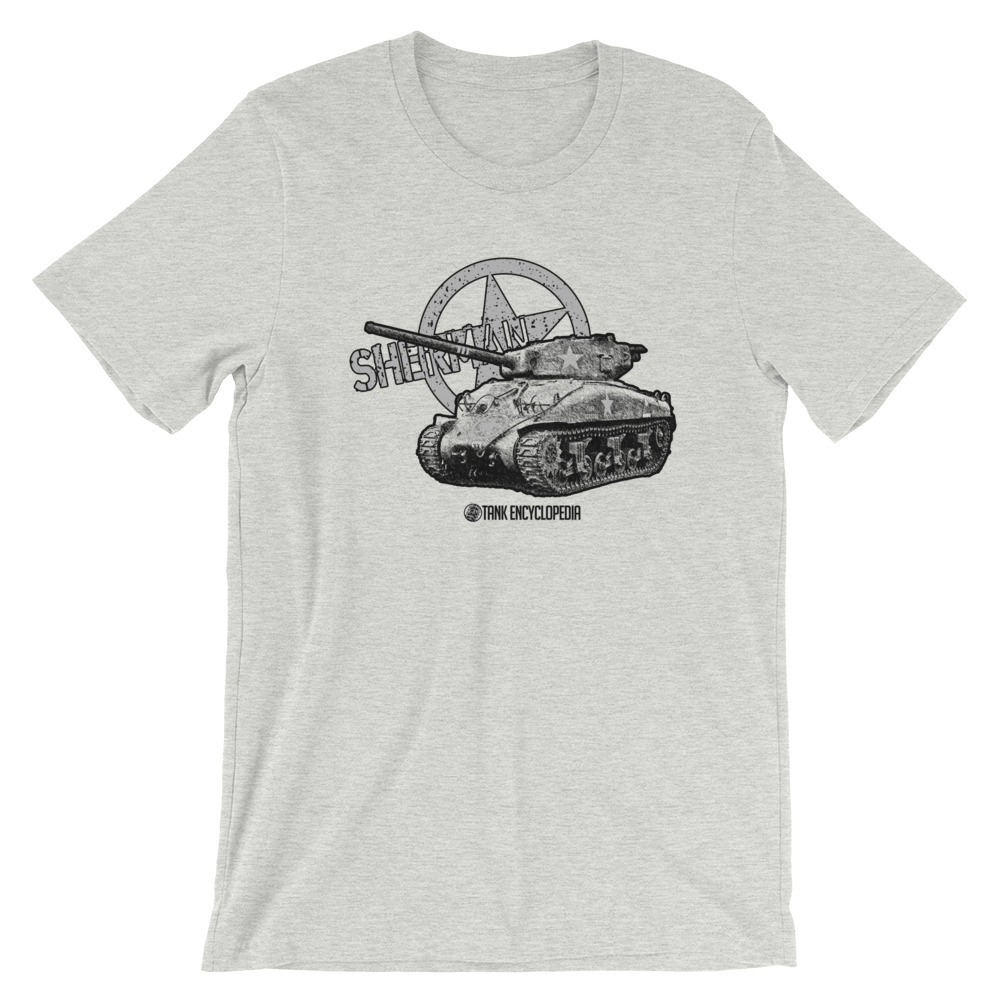
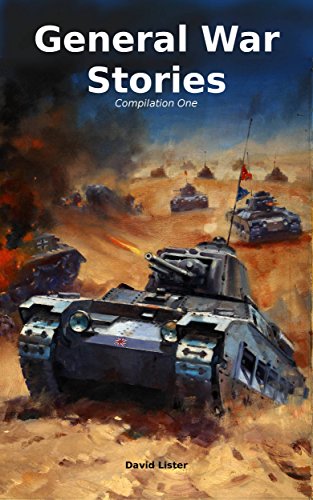
161 replies on “Medium Tank M4 Sherman”
To call the PzKpfw Mk.V ‘Panther’ a “mobile antitank pillboxes [sic]” is to stumble into the absurd. Even the slow and heavy PzKpfw VI ‘Tiger’ was much more than that. The Panther was a brilliant design, even as one may say the M4-series was; they were each the optimal machine of their respective “school” of armour employment. The ‘Panther’ was the near-perfect balance of speed, protection, and lethality. Its armour and chassis-turret design made it impervious to the US 75mm and 76mm guns either as a Tank Main Gun or as an Anti-Tank gun (towed or self-propelled) at its own stand-off range. It 75mm/L70 main gun could kill a M4 at ranges out beyond 3,000 Metres at any angle of attack. The M4 was the near-perfect attritional tank. Inexpensive, simple, and practically maintenance-free, the M4-series were available in numbers so great that their losses were essentially unimportant. The 75mm/L40 medium-velocity gun was a compromise between an infantry gun and an anti-tank gun, and while it excelled at the former, it was a failure as the latter. The reluctant addition of the 76mm/L52 high-velocity gun to the M4-Series did little to obviate the problem by the time it was introduced, although its poorer infantry gun performance was not an issue with the many M4 variants armed with the 75mm/L40 in service alongside it. The M4 simply could not beat the ‘Panther’; although the fortunes of war gave the M4 ‘Panther’ kills, the M4s principal virtue, its numerical preponderance, was not sufficient to give it superiority over the ‘Panther’. Even in the close country of the bocage, where the M4 might be within its lethal range at the outset of an engagement, the Panther proved the better tank. The same was not true of the ‘Tiger’, with its conventional late-1930s chassis and unexceptional performance. Like that other “invulnerable” slow-mover, the British ‘Mathilda’, the ‘Tiger’ was the antithesis of the M4, sluggish, mechanically unreliable, difficult to produce and a severe drain on German resources (including those looted from other countries). Here the M4s speed and agility could, and did, exploit the ‘Tiger’s’ vulnerable sides and rear, or its tendency to break down under mechanical strain.
The ‘Köngistiger’ almost fits your characterisation as a “mobile antitank pillboxes [sic]”. Unfortunately for the M4, the ‘Königstiger’ had a thoroughly modern chassis and turret design, so that even the M4’s superior speed and agility could not give it an advantage against the lumbering heavy tank. It 88mm/L72 main gun could and did obliterate the M4 at any range and any angle of attack. The only hope for the M4 was to try and wear the ‘Königstiger’ down, forcing its even more overloaded engine to fail, or to disable the heavy tanks’s running gear or treads. Against its closest German equivalent, the PzKpfw IV, the M4 was about even, one-on-one. The M4 had slightly better frontal armour, but inferior gun power. Both tanks were reliable, and the Mk.IV was fairly simple and easy to maintain. But in action, the German tank was overmatched by the M4’s speed, agility, and numbers, so that it could hardly ever hope to fight against the M4 one-on-one.
The real condemnation of the M4 is not immediately obvious, because it has to do not with the tank itself, but with tank crews. While the US Army could afford to burn up M4s at prodigious rates, it discovered that crew losses ran very close to tank losses, due to the heavy hitting power of German tanks and Anti-Tank guns, and the vulnerabilities of the M4 design. Tank crews may have been “easy” to train, but they still had to be trained. Trying to stick a farm kid into the drivers seat of a tank on the basis that he had driven a tractor was bad enough, but for the M4 to be effective, it had to shoot, and that meant it needed trained gunners. The losses in tank crews was sufficient to cause a crisis in the Fall and early Winter of 1944 that the German Offensive in the Ardennes did nothing to help. The idea that a mediocre tank designed to be built in huge numbers very cheaply could win through attrition turned out to be flawed. As British, Soviet, and later US tank development showed, it was the Soviet model that the US ought to have followed. Employing its vast industrial capacity to produce a superior tank like the Pershing (or one similar to the British Centurion or a more sophisticated version of the Soviet T-34) would have given the US Army fewer tanks, but far better tanks, when it came time to face the Germans in Continental Europe, particularly Northwest Europe. Without a vast reserve of trained crews to absorb losses, which would in turn have entailed the reduction of either the Pacific Campaign (impossible) or the European Strategic Bombing Campaign (unlikely), the M4 was not successful against German opposition after the close of 1943. Thankfully, the Soviet Union destroyed the German Army, or the M4s reputation would be far blacker.
Thank you for this generous insight.
About the comparison of “mobile pillboxes” which also concerned the Tiger which was certainly less agile than the Panther as you underlined.
“They acted more like some sort of “mobile antitank pillboxes”, does not imply they were. Far from it indeed. The Panther agility was excellent and the subject was already treated in the dedicated page, but the grossly exaggerated comparison referred to the tactics that were used when these tanks appeared in large numbers – when Germany was more and more on the defensive. This was to underline that in most engagements from Italy to Normandy German tanks were often placed in carefully prepared positions and fired from some concealment whereas the allied M4s were most of the time on the offensive in the open. That makes these tanks (like the Panzer IV -with the difference that the latter was nimbler) acting like “mobile pillboxes” indeed, at the exception of the Battle of the Bulge and rare late-war German offensives. The other points concerns also reliability and consumption for which the M4 had some advantages…
Please the M4 Sherman was a much better tank than what you made sound at the end of your… info sheet? ANYWAY the loses part i can see what you mean, but the Russians were doing the same with it’s mass produced tanks and stuff but saying “If the Russians were not there than the M4 reputation would be fucked” is stupid. The Red Amy did not single handily destroy the German army or Germany it’s self, it was a split action by both the Allied powers, and Russia. And if you say “The Russians took Berlin” as your excuse for the Russians defeated the Germans would be stupid, we let the take it fro we knew they would get there first and we consecrated of destroying German position around Berlin. So from what i can see is if either Russians or the American (And allies) were not were they were than the other side would be fucked. EX: No America to invade France in D-Day or to battle them in Africa= Fucked Russians, or no Russians to battle the Germans and keep them occupied till we got over there=no other allied powers.
Don’t get me wrong i love what you said but give the Sherman some credit man.
Bob’s right. It begs to be pointed out, that the M4 Sherman did not suffer the highest loss rate of allied tanks; That sad distinction goes to the Soviet T-34, which throughout the entire Second World War, was never able to get a loss rate of better than 3 to 1…And it’s lauded by many as being the single greatest tank of WWII…yet, it killed more of it’s crews than any other vehicle. If you ever read the Aberdeen testing results of a T-34 that had been shipped over for U.S. engineers to evaluate during WWII with the intent that we might produce it ourselves…the U.S. army had so many problems with it that they declined it, The M4 in their opinion being the superior vehicle.
The M4 did not fight off the majority of the German army. It often had air support options when things got to hard for it. The T-34 would keep going. Panthers and T-34s had to preform with the equivalent to suicide orders the German would not retreat and the Soviets would not stop. The Sherman would have had to give up under that type of combat. The Aberdeen tests are likely biased towards American equipment due to politics. Patton and Churchill where very anti-Soviet, given that a change to a Soviet weapon would affect there armies and admit the soviets could make something besides cannon fodder. They would block it. So even had the test ruled in favor of the T-34 it never would have seen service in Anglo-American forces.
I believe the US M-26 Pershing might have made a good replacement for the M-4 Sherman had the resources been made available for production.Unfortunately they came a year too late. I don’t believe the report posted online is biased towards American tanks, at least the one I read; it appears to have been written by a Soviet officer who was at the Proving Grounds probably in the early 1940’s. Patton would have been occupied in North Africa or Italy at the time and Churchill, despite his tendency to meddle in tactical matters would have been far above the level of analyzing a piece of military equipment. ( I say this knowing of his suggestions of designs for ships and AFVs – He did suggest the predecessor of the LST which the British called “Maricaibos”.)
All that said, the T-34’s problems noted were, in many cases, things easily rectified; how difficult would it have been to design a usable air filter and install it. (I would bet the Soviets did so upon receipt of the report.) Many other factors inferior factors were as a result of the American advantage in metallurgy and engineering.
This report discussed what the Americans decided needed to be done for FUTURE tanks, not as a method of “putting down” the Russians.
At this time the Americans and Russians were allies and while Patton might have been anti-communist I really don’t think he would have rejected good designs if they were offered. Regarding Churchill I could only quote his observation on 22 June 1941, that if “Hitler had invaded hell, he would at least make a favorable reference to the devil in the House of Commons.” (Or words to that effect.) The T-34 was a remarkable machine and certainly was a rude surprise to the Germans. It probably never reached the level of reliability that was the hallmark of the Sherman but I would guess that had Aberdeen tested a Brit tank they would have determined similar problems.as with the T-34.
The real fault of Stalin lay in the purges of his high command.
Had Marshall Tukhachevsky and his adherents remained in control of the Red Army instead of (Kliment Voroshilov) and had some real power, far fewer Russians would have died on the steppes. There were bigger problems with leadership than equipment.
The pressures of wartime do not allow the attainment of perfections and certainly that could be said of the Soviet Union with the German’s kicking in the door.
I agree with Zhukov. The T-34’s kill rate is messed up because, until late 1943, the Germans had air superiority over the Russian forces. Any tank force will be decimated if it does not have protection from friendly aircraft. Also, the Germans sent many of their best tanks and tankers into the Eastern Front, which meant that the number of tanks and the quality of their crews serving on the Western front were far inferior.
What the heck why are you saying that America’s report on the Russian T-34 was biased? the T-34 did kill more crew members when it was it than the Sherman did and the 3 tanks lost for every single german tank that they destroyed. the reason why there was a very high casualty rate amongst Russian Tank units during the war was mainly due to the lack of radios in the T-34s and the fact that unit commanders made their tanks conduct suicide attacks aginst well concealed and defended german positions.
the t 34 would not just simply keep going it was incredibly unreliable.
Oh, I can tell you, it WAS the Russian Army who beat the Germans !
My Grandpa was in the East and in the West and he told me the fight in the East was uncomparable harder and without any humanity. They live and fight like animals, but really bad ones, and also most brutal torture of PoWs and Civilians (on both sides) was a daily experience, even though by far not from all Wehrmacht Units, but the SD was everywere.
The Germans started the War against Russia from the beginning as a war of annihilation, not only to conquerror new Territories. Also in Regions were the population welcome the Germans as Liberators from the Stalin Regime (which happens really often, many Russians hate Stalin and hope dies last) People had to learn, they don´t come to help them.
In addition the Russians had not signed the Geneva Conventions, what makes it easier for the Germans to treat them worster then their animals.
This systematic annihilation was surely recognized by the Russians and leads in a fight without any mercy on both sides.
And don´t forget how the Russian Soldiers were treaten by their own Officers, or better by their Commissioners.
They stand behind them and everyone who wants to withdraw to the own Line were killed imediately by them.
So it´s not a miracle that the Russians had terrible losses, hated the Germans from the deep of their hard and pay it back when ever possible.
As result over 85% of all fallen german Soldiers dies in the East, including 4 Brothers of my Grandpa, he was the only who survived.
Nowadays the German tanks are often called synonymously for an unstoppable force, which is not true as we all know, in fact it was the Russian steam drum which could really not be stopped in WW2.
The T34 and also the KV or the JS were the ultimative nightmare for the german Soldiers, not only because they were hard to knock out, but also because they come in such numbers that the whole fields before the german Lines were completely covered with them.
Ok, there were no Commissioners behind the Tanks, but the russian Leaders find another way to motivate the Crews.
My Grandpa told me they find knocked out Tanks with welded hatches.
Nice idea, win or die, no other way.
Actually the Russians built arguably the best tank in WWII, the T-34. The M4 was a nice tank, but it couldnt handle the German tanks. Like one WWII tank vet I talked to alot, when asked how the M4 stood up he would say “Well the shell would come in one end, and the pieces would rattle around a bit then go out the other end, leaving a smoking ruined POS.” So I would believe his eye witness account more. The shermans never could match the German tanks.
that is the best description of Sherman I’ve ever seen
The M4 was sufficient as a tank for it’s job at the time. While being slightly inferior to the Pz IV we shall not forget that while in the progress of making the Panther the standard tank of the german army the Sherman typically had to face tanks it could deal with, even at slightly inferior odds. Encounters with Tigers and Panthers happened on a somewhat regular basis but history showed that numerical advantages and massive aerial support allowed them to remain the upper hand in such situations. The thought of the sheer possibility of encountering such superior tanks though was what possible gave quite a lot of tank crews nightmares.
Your evaluation of the role of the US is wrong though and a classical US wishthinking interpretation if I may say so. The Red Army DID single handedly destroy the german army or at least it was in the very process from 1942 on – with or without US support. That’s why it was allowed to the Soviets to take the enemy capital as a symbol of their unique war effort. The eastern front simply had a dimension that nowhere compares to the western front and thus is easily misinterpreted as of “equal” to the western front when it fact it wasnt. Claiming something like that would be as if to claim that the british front in africa would have had the same impact as the western front.
Without russian help Britain and/or the US could never have even dared to face Germany on european soil. Without allied help russia would still have won the war.
An excellent analysis: Can I inquire into the source of your expertise?
Sadly this “analysis” falls into the same old trap, any tank that suffers more losses from mechanical breakdown than combat is anything but perfect.
The Panthers were a poor balance of firepower, mobility and protection. Whilst they had a heavy frontal arc, their side was the same as the M4, and both tanks initially shared the fatal error of storing the ammunition in the sponsons. A problem that was solved in later M4’s, not so the Panther that continued to be easily set on fire either by a side penetration piercing the ammunition or it’s own engine catching fire due to a poor engine bay layout.
Theoretically the Panther was more maneuverable than the M4 but it’s overloaded gearbox and engine meant that once it came on heavy going it would break. In theory it could turn in its own length but attempting to do so was highly likely to immobilize it.
A gun capable to knock out an enemy at over 3000m is an unnecessary added weight and expense on a tank destined to fight battles where 800m was the usual range. Such over design and waste contributed to not only the rarity of the tank but also the impact of losing one.
It’s firepwoer was needlessly excessive, it’s mobility was poor and it’s protection was situational and caused issues with mobility.
The Panther (and the Tiger) never on any occasion “proved it was the better tank”. The history is there for all to see, the Panther never won a campaign, while the M4 never lost one.
Winning convincingly the Battle For Normandy and all other engagements that followed makes ” the M4 was not successful against German opposition after the close of 1943.” utterly laughable,
And yet the M4s lost to the Panther’s 5:1 in tank combat. Since 49,000 M4s to 6,000 Panthers split between two fronts would normally result in there almost never being an one on one fight I’d be careful making broad statements about how the Panther performed when it worked and was properly handled by a well trained crew. By late 44 well trained German crews were rare and the handling of all their tanks were suspect yet those German Tigers (both versions combined) averaged 4.7:1 kill ratios over all tanks most being Soviet tanks and the 49,000 T-34 76s and -85s alone were destroyed between 4 and 7:1 despite the gross numerical differences. By the time of Bulge, the number of Shermans in Europe alone out numbered total German tank production for the entire war and every American infantry division has an attached Sherman and M10 battalion. There were 65 independent American Sherman tank battalions alone. Every German 75 gun would destroy every Sherman except the Jumbo at any range it could hit it. Its not hard to find photos of Panthers hit multiple times from the front by 75 and 76 Shermans that failed to penetrate while said Panther killed several of same at what you call normal combat range. At least one famous case of a Tiger 2 crossing in front of 5 Shermans at what was billed as 1000 yards and taking fire that neither damaged or penetrated that side armor. Said Tiger killed three of the Shermans with ease and disappeared out of harms way. It crossed ground the Shermans could no cross because its track system was superior cross country even while having a higher ground pressure. Same for the Panther. It could go places the stock Shermans could not. No such thing as excessively powerful anti-tank gun. The Sherman’s 75 would not penetrate the frontal armor of Panther, Tiger 1 or Tiger 2 with the barrel at point blank range. As for the Panther and Tiger never on any occasion proving it was the better tank, 5:1 kills in favor of the Panther and Tiger in one on one combat proves that all day long. American tank crews didn’t scream “tiger” every time they saw a German tank for no reason. All else equal a comparable number of Panthers in either offense or defense defeats the Shermans armed with either the 75 or 76. By the time the Shermans encountered any comparable number of Panthers it was very late 1944 in the snow and the 10th Armored’s Shermans setting on defense didn’t seem to better the inferior number of Panthers and Tigers sent its way. Its hard to flank a mass of tanks sent your way that none of your anti-tank or tank guns will penetrate until you can see the whites of their eyes. That’s how German Bulge forces pushed as far as they did and the reason it took as long as it did for grossly superior number of forces and tanks to close the bulge. 5 Shermans lost for every Panther in one on one tank combat. Even the Mk4’s 75 would destroy the Shermans far better than the Sherman 75s could destroy it and the Mk4 was generally inferior except in gun power. About 1600 Mk4s and Panther’s in France spread out among several understrength Panzer Divisions at the time of Normandy. At no time after the initial landing did the Germans have more AFVs than the Allies. The British gave a vivid demonstration of the inferiority of the Shermans around Caen. After the first 30 days it was completely loped sided in favor of the Allied AFV numbers yet those inferior number and what you claim are inferior tanks took a great toll against them, far greater than their numbers else they would have simply been overrun by the vastly superior number of AFVs the Allies put ashore within the first 30 days. 5:1 loses when the Shermans went head to head against the Panther is the historical record. Between reliability, war time shortages, fuel shortages and declining crew training only a fraction of the total German tank forces in theater were actually available for combat from 1944 on. The Allies had no such problem on the Western Front. They could always be at full strength or better as long as they had crews. Numbers won WWII. By 1943 the Germans were outnumbered 3:1 in combat forces. By 44 that was closer to 5:1. One recorded battle puts Shermans and Panthers on an even outcome and that is the go to for all such stories where the Sherman stands up to the Panthers yet the kill ratio of Shermans lost to Panthers is still 5:1 overall for the limited time those two could even be engaged. No one would ever say the Mk4 was superior to the T-34s on paper yet something had to kill the bulk of the T-34 production and leave the Russians with just 12,000 total AFVs out of 87,000 produced in April 1945. Even the JS2 fell to the Mk4s 75 gun at “normal battle” ranges. The lowest kill rate went to German Assault guns of which 9000 75 armed versions killed 13,000 tanks. Something had to account for the thousands of burned out Shermans on the Western Front. Panther strength probably never exceeded 700 at any time including Bulge. Contrast that to 16,000 Shermans in theater. Be thankful the Germans couldn’t produce 12,000 Panthers, put fuel in them and maintain the crew quality they had in the early part of the war.
What next the Me-262 was a waste? One group, operating from Dec of 1944 to the end of the war, never having more than 30 operational planes shot down 427 planes of which 300 were heavy bombers. Hitler, the best Allied General delayed the Me-262 by a year all by himself. No dog fighter by any stretch but against heavy bombers it was their death in great numbers. No American tank produced after the end of WWII follows the design and thinking that went into the M4 Sherman. The Abrams M1 is a lot more Panther in thinking than anything Sherman. We spare no expense in making the Abrams work as designed. It failed its initial tests when introduced in Europe. It was our war time Panther then and unreliable. The M1 that went into combat in Kuwait in 1991 and again in Iraq in 2003 had no superior and it worked as required. Fix the Panther problems and produce it in sufficient numbers and the M4 Shermans and T-34s become the T-54/55/62/72s the M1 slaughtered when handled properly and in mass. Western Europe was covered by thousands of burned out M4s by May 1945.
If the Panther wasn’t superior to the Sherman than why did that famous fight between a Panther and a highly modified T-26 with the extra 80 mm frontal hull armor from a Panther welded to hull and gun mount with the extra long 90 MM gun take place after said Panther took out two Shermans? Why weren’t more Shermans sent in against just one lone Panther? All things equal the Panther wins hands down against the Shermans. Very little evidence that all else being equal was even possible given the gross differences in fielded numbers of Panthers vs Allied Shermans and Russian T-34s yet both the Panther and Tigers racked up an impressive kill ratio against Allied and Russian tanks. American Tankers weren’t laughing at the actual results they had to endure. Any tank can be reduced to a pillbox if taken in the flanks or rear. Tanks don’t win campaigns. Men do. With the gross loped sided material forces opposed against the Germans by mid 1944 the attributes of no vehicle or machine is going to overcome the gross numbers but when making comparable vehicle comparisons any comparison is invalid that doesn’t do that on a one for one basis.
Allied tank crews often outplayed, outwitted and destroyed their “superior” german counterparts from 1943 onwards. The M4 is just slightly worse, and the E8 is much better than the Panther; Much better visibility, turret traverse, reliability, and it’s easier to escape from. And the fact that tank battalion commanders were still requesting 75mm Shermans as late as 1945 proves that the M4 was still match for the Pz. IV’s and StuG’s that it usually faced. Panthers and tigers were usually given to new t
ank crews to make up for their lack of skill, and Pz IV’s were usually given to experienced commanders. When deployed against Pz IV’s, M4’s usually won.
The IS-2 had 120mm of sloped frontal armor that was proof against the Pz IV and StuG III’s gun at normal combat ranges. (300-1500m)
I’ll adress your Me-262 rant later okay?
The M4’s were ambushed, plain and simple, who shoots first, wins first. There are many cases of this happening to Panthers.
nonsense
nice facts and you’re not wrong
Thom, kill ratios needs to be treated with a big load of salt as the claimed numbers from the units are now being actively researched. The OKW applied a 50% cut to all the German forces destroyed claims, to allow for recovery and repair, however this may not have been enough.
“Following access to the Russians records, at Kursk the latest analysis of tanks destroyed claims made, after the 50% cut, are higher than the total Russians Tank force involved. All units reported 16251 destroyed tanks for Kursk applying the 50% cuts reduces to 8125 claimed against a total Russians force of 7360. Tiger and Panther vehicles claim 1300 total, so 650 after 50% cut. The actual ratio between the 6064 Soviet losses and the estimated 1712 German losses is therefore not greater than 3.5:1.” Panzerworld
Consequently, the Panzer Ace high numbers of kills are coming under significant review has information is being made available.
British after combat analysis published 1946, the ratio was 3 Commonwealth Tanks to 2 German Tanks. This is because the successful engagement of 75mm Tanks Sherman, Cromwell and Churchill average was 450 yards, whilst German Mark IV, V and VI was 1100 yards. However, the Commonwealth crews had the 17 pounders Firefly, Challenger and Comet to provide over watch and they were also successful at 1100 yards. So balancing combat, particularly the Firefly the best Sherman tank destroyer.
The issue for the American crews was until Pershing arrived as overwatch for the Sherman 75mm and 76mm they had to use tactics, which they were very good at. R P Hunnicutt, the authority on Sherman covers this page 212 and 213 with the 90mm Sherman. When the Panther was finally sorted late in the war, the problem was the novice crews poor use of them. The American crews were better and made better use of the Sherman’s advantage.
I think you wil find the 5:1 Sherman ratio is a myth, many believe it came from there are 5 Sherman’s in an American platoon, or the other possibility is you can build 5 Sherman’s for 1 Tiger.
After the war, given there were loads of Panthers the French used them in their armoured divisions and produced comprehensive reports on performance. Paraphrasing, Great when they worked.
Reference
, I would refer to Stephen Napier’s book The armoured campaign in Normandy June-August 1944 ISBN 9-780750-962740 is an excellent book on events. Specifically for Wittmann, Tiger Tank Marcus Crowper Osprey Publishing ISBN 9781472812940, this includes detail from the Northamptonshire Yeomanry war diary. Also British Armour in the Normandy Campaign 1944 Professor John Buckley ISBN 978-7146-5323-3, and Bayerlein, after action reports of the Panzer Lehr 9-780764-323423, Tigers in Normandy Wolfgang Schneider ISBN 9-781848-848023; and Steve Zaloga Armoured Thunderbolt ISBN 978-0-8117-0424-3 these are excellent as they all point to archive material which has now been released, which is changing the original narrative. Refer to claims, you may find this interesting, https://panzerworld.com/german-tank-kill-claims. This is an excellent site, which got me into researching, particularly around operation Goodwood, the references supplied by the article, obtaining a number of the books and articles. Additional this may of interest http://www.dupuyinstitute.org/blog/2018/07/23/armor-exchange-ratios-at-kursk/. War by Numbers: Understanding Conventional Combat by Christopher A Lawrence I hope this helps, good reading.
lmao you believe nazi propaganda
From all sources, including front line operators, the Panther’s mobility/flotation was better than the Sherman’s. In fact, there was a program to increase the Sherman’s recognized mobility issues which started as fitting wider end connectors (grousers) on the outside of the tracks, and included some spacing out of the wheels/suspension so that the same end connectors could be added to the inside of the track. I’m not sure if the latter served overseas. The penultimate in improving M4/Sherman mobility was the much wider HVSS suspension.
I think what you, and perhaps a lot of folks are combining the two characteristics of mobility and reliability together when you talk about the Panther’s issues. I was involved with tank procurement (after my first regimental tour) in the very late 1980s and there was another characteristic used in addition to firepower, mobility, and protection. It was called RAM-D and stood for “reliability and maintainability – dependability”. I think this is the characteristic in which the Panther was very low on the scale.
All the best.
The Tiger had the same modern suspension the Panther and Tiger II had.
They were much more agile than you seem to think.
Outmanoeuvring them was based on superior numbers, not superior agility.
In regards to the Mobility of the Sherman versus the Panther V and Tiger VI. The Sherman had good mobility, better than the latter Panzer IV I believe. The two big German tanks however had very broad tracks and LOWER ground pressure and were not inferior in cross country, perhaps better. The number of wheels and their diameters is also very important. The Panther and Tiger because of their overlapping or interleaved wheels had both large diameter wheels (as on the big wheel T34) which minimized peak ground pressure but also had twice as many wheels (the Sherman had multiple wheels but they were small) which also minimizes peak ground pressure. Thus the Panther and Tiger had lower peak ground pressures than the T-34 or Sherman. Furthermore the long travel independent torsion bar suspension of the German tanks kept the Wheels forcing the track on the ground further reducing ground pressure over uneven and challenging ground. There was no cross country mobility problem. The great width of the Tiger made a rail transport in some occupied countries difficult. Obviously weight also effects traversing bridges difficult but one could always send the Panther ahead or the Tiger or the Panzer IV ahead of the Panther while the big tanks provided covering fire and the bridge engineers did their work. Reliability of the running gear of the Panther/Tiger was an issue if the tanks didn’t get regular maintenance but those problems were disappearing as the problems were identified and fixed in future production runs. The final running drive problem of the Panther is well known. It simply gets down to the Germans not having sufficient tooling to replace the straight cut gears with herringbone or planetary(as they planed in Panther II). Even fitting Tiger final drive to the Panther would have fixed the issue. The solution was simply driver training.
“inexpensive”
A Sherman was almost had the same price as a Panther.
Tiger’s mobility was quite excellent for a heavy tank of its era. Furthermore, it was mechanically reliable. It is Panther which is famously unreliable design with overloaded transmission. Your praise of Panther and disdain of a Tiger is uninformed in some regards. Neither Tiger was “a massive drain on resources”. It was more expensive tank than either that is for certain, but non of these two other tanks could meet the role Tiger was designed for nor was as effective during the time Tiger was in numbers and unlike Panther, reliable tank.
ye are aware the british for the germans were the biggest threat and they didnt even take a mediocre approach. they went by a doctrine which was partly flawed but overall was enough to match german technical advantages as the panther would have to close in on heavier armour and would have to rely on extreme luck to manage to destroy the lighter armour before they would retaliate. most times werent the case as access to not only air support but fast tanks could easily flank and take the panthers side armour quite easily.
It is not just the tank that should be taken into consideration here the m4 sherman was a very reliable tank that was logistically great. it had a great mortality rate and was quite survivable in comparison to other vehicles. it would be more reasonable to compare the panther to the t 34 which it was, to put it simply designed to combat. also you seem to not have considered the infantry support role which the sherman did quite well at unlike the panther which could be penetrated by Russian anti tank rifles from the side. go back to warthunder mate
I would like to point out that the T-34s in general are very overrated tanks. And before you call me a Wheraboo, I am a firm believer that Germany could have not won the war under most circumstances and am most certainly not a Wheraboo. Sure the tanks had good guns, moderate armor, and pretty good speed. However, the T-34s lacked heating in the early models (like the T-34/76s) and had cheaply made armor so the armor would fracture easily under enough pressure. I could go on, but it’s been a while since I’ve done in-depth research on the tank so correct me if I’m wrong. Also, the Panthers and Tigers were a good design on paper but were so rushed due to limited time and resources so never went under proper trials, leading to poor performance on the front. this is especially shown on the eastern front because of the terrain, weather, and the ever-increasing pressure of the Red Army.
To say that the Panther ws impervious to the 75mm Sherman completely ignores the battle of Arracourt where the U>S. 4th Armoured Division 75mm Shermans completely bested the 5th Panzer Army’s Panthers. While the frontal armour of the Panther was impervious to the 75mm, the sides and rear were most definitely not. The Shermans used the fog and carefully chosen ambush positions to inflict heavy losses on the Panthers and win a decisive victory over the Panthers. Included in that battle were a few M-10 and M-18 tank destroyers that inflicted very high casualties on the Panthers for very few losses using tje 3-inch and 76mm gun respectively. These guns were very similar in performance and, despite you saying that they had little effect in improving the situation, testing done between the highly effective 17 pdr and the 76mm gun M1 at Aberdeen testing grounds showed that the 17 pdr was only marginally better than the gun M1 and was the reason the Americans chose to go with that gun instead as it required less reconstruction of the turret. To clarify, Germany lost 200 tanks and sefl-propelled guns at Arracourt, America lost 41 Shermans and 14 tank destroyers. Just in the Arracourt region alone, Germany lost 118 Panther tanks, 101 Pz IVs and 122 Jagdpanzers and Stugs to the allies losing 151 Shermans and a few dozen M-10s and M-18s. Showing clearly that the Sherman was besting the German armour by a considerable amount in the South of France.
Do you have any information about the weight of the M4A3E2 turret ?
Hello, this Website has very detailed information on US armored vehicles. Here’s the Jumbo stats: http://afvdb.50megs.com/usa/m4sherman.html#JUMBO
Thx but sorry,visited before ,could not find what
I need. The only thing come close is the Wot in-game weight of the M4A3E2 turret,which is very hard to confirm that it is historical or balanced.
It’s rather hard to find such data.
Hunnicutt mentions that the M4A3E2 weighed, combat loaded, 84000 pounds, but no mention on the turret alone.
I could not find further information.
Sorry
I am thinking that this would be the only guy have the information I need.
btw thx
http://www.toadmanstankpictures.com/restore.htm
Long time late comment, but I have the weight of a few vehicles, hulls, and turrets. Be sure to comment any corrections, and check back on occasion. I have the Jumbo listed.
https://docs.google.com/spreadsheets/d/1_hZl1bBdJWpdtSUsPJPeNN0qFfYvqliry9DeHyf_Cg0/edit?usp=sharing
No where do I find the early trouble with the driveshaft failing and ‘corkscrewing’ taking out the drivers right arm.
Hello Jim,
Unfortunately a quick search has yielded no results on this topic. Could you please point us to a source?
This was awesome and all but I was looking for a chart that had the info I needed like the wieght and armor stuff like that but I did learn new things. I just don’t like reading so much to find info I need. PS sorry about my spelling I am 13 a beginner In WW2 tank research.
Nice! Starting early just like me, you’ll only get better and better. For Sherman info in a chart, this website works wonders:
http://afvdb.50megs.com/usa/m4sherman.html
Coal, never underestimate the value of “reading so much stuff”. Charts are, by their nature, some one else’s conclusions. Learn enough to make your own. If your research is as good as your spelling, you’ll do fine.
I started researching in my teens as well. everyone has their own opinion of tanks. for instance, some say the sherman has 50, 75, 76, 108, 118, 130, or even 178mm in armor on the front, but I still don’t know. try and find what seems accurate to you
I think the only Sherman series that had over 100 millimeters of frontal armor were the Jumbos
If the Sherman was angled 60 degrees the tigers 88 and panthers 75 couldn’t penetrate the Sherman’s armor and this was said by a German tanker the Sherman was a good tank but one of the faults was the Sherman’s ammunition was breaking against the tigers and panthers armor by the weak metals used in Ap rounds and bad ammunition placement and Patton refused to use the Pershing because his view was for the battle proven Sherman And USA battle doctrine for tanks was to support infantry not fight tanks and the Pershing shot right through t34s in Korea but don’t go downing it for it flaws it don’t matter long as its gets the job done
Brian, as to the content of your reply, it is entirely representative of all three of the major problems one encounters when dealing with weapons systems in any era: Ignorance, Partisanship, and Prejudice. Ignorance is excusable and curable. Alas, partisanship and prejudice are neither, and are fatal to the remedy of ignorance.
Some pointers, as a primer for your reply: site a source if you are going to claim “a German tanker” said such-and-such. In an informal setting like this, it is generally acceptable to take well-known points “on faith”, even if one is going to argue about them. But facts that are “revisionist”, like claiming that the M4 General Sherman’s armour was proof against the KwK36 and KwK42, must be supported by reference to documents.
In this case, had you attempted either, you would have discovered that you were wrong. Whatever your “German Tanker” may or may not have “said”, the general fact of the M4A being vulnerable to penetration by the 8,8cm KwK.36 and 7,5cm KwK.42 is not in dispute. There are ballistic calculations—both simplified algebraic and original derivational calculus—to prove it mathematically. There are copious original source records extent and readily available that prove it historically. Even anecdotally, a modicum of checking would have shown you that your “German Tanker” was alone in his contention.
If you had done this research with an open mind, intent on learning for yourself what the pros and cons of the M4A series were when pitted against the German PzKpfw VI Tiger and PzKpfw V Panther, you would have quickly discovered that you were wrong on every point.
The US Army’s manual for the employment of Tanks stresses their offensive role, and their use in combating enemy tanks. The idea that American tanks were not meant to combat enemy armour is not a product of scholarship but of apologists. In US Army doctrine Tanks in Armoured Divisions were offensive weapons, meant to be employed in breakthrough operations and deep penetrations of enemy lines (just like “Operation Cobra”). Tanks in Independent Tank Battalions were intended to support infantry operations, again including combating enemy armour.
The statement, attributed to General Patton, that “In mechanical endurance and ease of maintenance our tanks are infinitely superior to any other.”, damns the Sherman (and the even more obsolete M5 Stuart) with faint praise. The military mission of a tank is not to be reliable or easy to maintain. Look at it this way, Brian: no tanker in the world would want “reliable” over “immunity to known enemy weapons beyond 500M” or “Kill probability with conventional ammunition is .1 against all enemy armoured fighting vehicles to 1,000M from all angles”.
The performance of the M26 Pershing in Korea is not relevant here.
The M4A could not master its German foes, full stop. A Kill Ratio of 1:4 is no one’s measure of a successful vehicle of any kind; the M4 manifestly did not get the job done. The men who fought the outclassed and obsolete M4A-series tanks got the job done, in spite of appalling losses and bureaucratic betrayal. Imagine such men fighting from the M26. Imagine how many more might have come home.
Well, speaking of bias, you seem to have rather obviously chosen a side. The Pershing was (at least in theory) ‘better’ at fighting tanks 1-1 on a flat plain like in a video game, but unfortunately it was somewhat mechanically unreliable. As much as you dismiss its performance in Korea, it is true that, when it came to fighting other tanks, the Pershing was favoured – but in every other situation, the Sherman was preferred. The deployment of both Pershing & Sherman in the same theatre in large numbers (as opposed to the much smaller deployment of Pershings in Europe) is entirely relevant. And it’s a staggering statement of military ignorance to say that a tank should not be reliable or easy to maintain. Obviously these should not be the sole factor, but if you think focusing solely on total immunity to enemy weapons or firepower to the expense if it being an actually effective weapon of war (ie ‘can this tank get where it needs to be’). It doesn’t matter how invulnerable it is, or how powerful the gun is, if it can’t get to the battlefield when it needs to be there. You say a tanker wouldn’t value reliability over being able to knock out enemy tanks – but I think the infantryman would much rather have a reliable tank that’s there when it’s needed to knock out that machinegun nest that’s killing his buddies, rather than some ubertank that broke down on the way over. We literally have a direct comparison between ‘mass produced, reliable tanks’ and ‘vehicles designed to be THE BEST’ with the US/Soviet methods of tank deployment vs. the German one – and the point has to go the Allies, there. The Sherman seemed to master its German foes (which were, most often, not Panthers or Tigers at all, but AT guns, Stugs, PzIVs or infantry with AT weaponry) well enough to do the job. Shifting entirely to churning out Pershings would have massively disrupted the entire allied chain of supply (while manufacturing Sherman variants meant production efficiency could be retained – I believe there’s even photographs of Leee/Grant production lines where the last M3 is rolling off the line while the first Sherman is right behind it with no halt in production) for what would likely not have been much greater gain, strategically. Yes, there’d be more powerful tanks, but less reliable, and fewer of them, and that would have reduced the flexibility of the Allies and arguably stretched out the war.
It’s very easy to play ‘what if’, but honestly considering how even 5 years after the end of the war Pershings were still not as reliable (or favoured for my other role than destroying enemy tanks) as the Sherman, it seems to me that continuing production of the Sherman was the right choice. Maybe not a popular one, but considering the actual logistical and tactical situation, making and modifying a proven weapons system rather than deploying a tank still in development was the wise thing to do, as the reliability and ease of maintenance meant the Sherman could prove a vital component of the American combined arms system.
It’s just unfortunately bugbears like the Ronson nickname (is there any contemporary proof of this being a real nickname? As I understand it the ‘lights first time’ slogan was a postwar invention) and the 5:1 kill ratio (the Battle of Arracourt puts paid to that one) have lead to a great many people dismissing it as a deathtrap.
I agree with you 100% of the way
bit harsh at the start but well said
Just keep in mind that Patton believed the tank’s most important weapon was the machine gun
Major new upcoming book on the Sherman tank-
“For Want of a Gun: The Sherman Tank Scandal of WWII.”
http://www.schifferbooks.com/for-want-of-a-gun-the-sherman-tank-scandal-of-wwii-6155.html
What’s the different of M4A3(76)W HVSS https://www.tanks-encyclopedia.com/ww2/US/Medium/M4/M4A3(76)w_HD.jpg
with the M4A3E8 https://www.tanks-encyclopedia.com/ww2/US/Medium/M4/M4A3E8_Germany1945.png ?
Same tank, different name.
The tank’s actual name is the “M4A3E8” (or, “Easy Eight) but, like most M4 Sherman variants, shared a longer, more specific name, the “M4A3(76)W HVSS” (76mm gun, HVSS suspension).
For a very good comparison of the Sherman Vs the T34 from a crew combat viewpoint; there are two books written by a retired Russian General of Tanks. He served in the Northern Front in British Matildas’ and subsequently on the southern front in Shermans, followed up with the Invasion of the Kuriles. He has some very interesting things to say about the combat functionality of the Sherman and the T34.
Sorry, I cannot remember his name, or the titles of the books. As for the really bad reputation of the Sherman in Western Europe, that was as much Flawed American Combat doctrine as it was the design of the Sherman, when the Allies invaded Europe, All the 76mm armed Shermans were left in Britain, as they didn’t fit the doctrine of Tanks (for fighting infantry) and Tank Destroyers ( with very minimal armour, but a good gun) for fighting tanks. The British had recognised the need for ANY tank to be able to fight another tank, hence the Firefly, unfortunately it wasn’t produced in enough quantity to equip all british units.
nice
T 34 Soviet Medium Tank around 85,000 were produced during the war a few months ago I did some research on this tank.
It was not all that it was cracked up to be.
The Model 1940,1941 and 1942 tanks were armed with the Soviet 76.2 mm Guns of which there were two versions.
The turret lacked a turret basket big issue most of these tanks including the vaunted T34~85 lacked radios.
The model speed 1940 1941 and 1942 Models the Turrets were so cramped to begin with for two men, you were basically trapped.
The Hull crew had one hatch and they were also working in very tight quarters.
They had a six transmission that was a Russian bear to operate and was unreliable,_On Road marches they would have to stop them and cool them, Their main gun ammunition also had issues.
I have seen many photographs of T 34’s that were obliterated.
Location of fuel tanks one was in the fighting compartment with the main gun ammunition.
Panzer kampfwagen Mark III’s with the 5cm L60 gun could kill T34’s they just had to get in a little closer.
The United States got caught with it’s pants down thanks to civilian politicians!
THe M2 medium tank was the new tank armed with the 37 mm gun and a load of machine guns.
We were not in a position to build a new tank from the ground up so they took the best components of the M2 its suspension system for example enlarged the lower hull and Built over 6,0000 M3 medium tanks the main production model had riveted armor and made use of either the M2 or M3 75 mm gun on a sponson mount and of coarse the turret had the main antitank gun the 37 mm gun. The 75 mm gun was alow velocity weapon meant more for artillery than killing other tanks but it could be done they also had six or seven 30 caliber Brownings could be carried original crew members number seven but modifications reduced the crew to six in U.S. M3’s and the British M3 Grants as they were called had a reduced crew of Five, There was also a cast hull version and a welded hull version they also used either gasoline engines or deasel engine. The tracks of the M3 were to be one of the weak points they had large square like pads that had no gripping power._early M4 Shermans used the same track.
The M3’s and early M4’s used the same suspension system three trucks per side each had two road wheels with the return roller set in an (A) frame configuration. Latter production trucks had off set return rollers.
Early M4 Sherman’s be it the M4,or, M4A1 ,or, M4A2 , or M4A3 made use of the M3 Medium lower riveted hull.
The Upper hull of the M4 M4A2 and M4A3 were welded hulls and had direct vision ports for the driver and hull machine gunner and also had three .30 caliber machine guns side by side one in a ball mount and two mounted on trays barrels went through slots cut into front hull armor,these two were quickly done away with._and only the ball mount remained.
It is said that some of the early sherman were armed with the shorter barrel m2 75 mm gun just as were the M3 mediums were.
Most were armed with the longer barrel M3 75 mm Low velocity gun howitzer.
The fact is both tanks were designed to support infantry operations just like the German Strumgeschultz’s were.
In the early part of the war the United States was going to rely on towed Antitank guns and Half track mounted tank guns.
They then decided to design a purpose built fully tracked anti tank gun based on the lower hull of the M4 Sherman tank specifically the M4A2 the
and its diesel engine it was called the M10 the upper hull made use of angled welded armor and was armed with a 76 mm high velocity Antitank gun. early M10’s also made use of the (A) Frame style Trucks that erly M4’s and M3’s used and most likely the early tracks as well.
The turret was open top construction and its armor was lighter so as to increase speed and mobility they say and it was used in north Africa.
This was the tank that was designed to hunt and kill enemy tanks,not the Sherman nor the lee, but in combat that did not always turn out to be the case.
Hello Mark, thanks for your insight, however for production numbers: 115 T-34mod40 tanks in 1940, 2,996 T-34 in 1941 (with about 2,907 T-34mod41s), 12,661 in 42 (11,999 mod42s), 15,710 in 1943, 14,948 in 44 (with 21,138 mod.43) and 12,551 in 1945 (19,659 T34/85s) , this would indicate that from 1940 to the end of the war around 58,000 T-34s were produced, from june 41 to May 45 it would be around 55-56,000 tanks. Note that some sources state slightly different numbers. 84,070 refers to the total numbers produced (post war, Korea included)
Best regards
What was the m4 DD use for because I have never heard or seen one of them before
Thx
P.s fantastic site keep up the great work
http://olive-drab.com/images/id_m4_sherman_dd_04_700.jpg
it was used for the amphibious landings at Normandy, though to little effect, due to the fact that they were tested on rivers, not ocean, so with fire going on all around them they often sunk before even reaching the beaches, DD standing for Duplex Drive, where a shaft running from the transmission drives an aft propeller
The 39th Sherman’s description has an error. The second Russia is spelt “Prussia”. It’s the Sherman with “To Berlin!” on the side of the tank.
Hello Jack.
It is correct, it is in Eastern Prussia. It is a historical region which was German and now is Polish, south of Lithuania.
Oh. Sorry, I should have done my research first, thank you for correcting me.
Did the Canadians use Sherman Mk. II, IV and V, etc., or the regular M4 Sherman’s?
So, during the war they got Shermans I, III and V from the British, in various armament configurations (75 mm, 105 mm, 17 pdr).
They also built the Grizzly, which was based on the M4A1.
After the war, they bought M4A2E8s from the US.
During the Korean war, they were loaned M4A3E8s from the US
Alright. I was also wondering: what’s with all the different types of wading-gear?
Some have different tops, some different bases:
https://www.tanks-encyclopedia.com/ww2/US/Medium/M4/M4A2_med_iwojima_march45.png
https://www.tanks-encyclopedia.com/ww2/US/Medium/M4/M4A2_med_KingKong.png
https://www.tanks-encyclopedia.com/ww2/US/Medium/M4/Sherman_MkIII_3ndCL_yeom.png
https://www.tanks-encyclopedia.com/ww2/US/Medium/M4/M4_Sherman_DWG_amphibious.png
For the Russian M4A2(late production) it says it had a 47 degree frontal armor, but also had an additional 108 mm of armor added on… Is this true? I’m just a little confused was this a field conversion cause the picutre for the tank looks like a normal M4A2(Late Production) Sherman.
The above site and development history of the M4 Sherman fails to mention one of the most important transitional elements in the use of many components from the M3 Lee tank when designing the Sherman. That is the design and construction of the Canadian Ram tank beforehand. A cursory examination of this tank reveals that with the exception of a slightly modified glacis and a redesigned turret capable of holding the larger 75mm main gun, the Sherman is nearly an exact copy of this tank. The Ram design incorporated the suspension, engine and drive train of the M3 Lee, but utilized a lower profile cast hull mounting a turret containing the main gun – originally a 2 pounder which was eventually upgraded to a 6 pounder (57mm). This conformed to what was then British military doctrine which called for a “cruiser” style tank. By the time (1942) there was an urgent need for a more competitive American tank, it was apparent that a larger gun like the Lee’s 75mm was necssary to deal with the then most prevelant German Mk III and Mk IV tanks. As the Ram had been designed with a turret ring too small to accommodate the 75mm gun, the Sherman’s design rectified that situation with a larger turret ring and a slightly different turret design. The Ram tank did not see combat except as a headquarters communications tank serving with some Canadian tank squadrons, and as modified by the removal of it’s turret to become the allies first APC known as the “Kangaroo”. Thousands of Ram tanks however did fulfill a vital crew training function in Canada and Britain because in most respects they were identical to the Sherman tanks that Canadian Army crews first fought with in Italy and later in Northwestern Europe. The later version Ram II also featured return rollers moved aft of the main suspension units, so by the time that the first cast hull versions of the Sherman began rolling off the assembly lines, with the slight exception of the turret, they looked like nearly an identical copy of the Canadian Ram tank. Much of this information is available in my book “Fighters, Bombers, Tanks, Wolves: Gitchigumi” which is available at Amazon Books.
That is because we have a separate article on the Ram: https://www.tanks-encyclopedia.com/ww2/canada/Ram_Cruiser_Tank.php
-TE Moderator.
Just checked out your article on the Ram tank and it is excellent. Thanks for the heads up.
You are most welcome, kind sir. 🙂
-TE Moderator.
Fantastic info on these Shermans. My grandfather drove one during the war so its always been my favorite.
Keep up the great work guys! This is my new go to site for anything involving tanks.
Glad to hear it, Kevin. Does your Grandfather have any interesting tales?
– TE Moderator
Sadly he passed away when I was young. I never really got a chance to talk to him about any of it. From what the rest of the family has said he didn’t like talking about it much. He was in the Pacific, Peleliu and Okinawa. Reading about what those battles where like I can only imagine that what he witnessed was horrible which explains why he didn’t like discussing it.
He bought me a little Sherman tank made by Corgi when I was a kid, I still have it.
Sorry to hear that, Kevin. That is very similar to my own grandfather. He was in a Royal Artillery Anti-Tank Rgt. during WWII. He didnt say much either, not many of the war-fighting generation do, but when you read about the events you can understand why. And like you, my grandfather died when I was also very young.
– TE Moderator.
Well then Mark lets raise a glass of cheer for our grandfathers. Because without men like them doing that kind of job at that time then the world would have been a very dark place indeed.
Cheers.
Here, Here! Cheers!
– TE Moderator
I find it interesting that people think the Russian T34 was all that and a bag of chips, and that it was superior to German tanks. And that German tanks were superior to American tanks. But during the Korean War the US Army replaced their unreliable M26 Pershings with M4A3E8 Shermans, and the Shermans did not seem to have too many problems defeating T34s.
Most late war german tanks in a one-on-one fight could defeat any allied tank at the time. Infact, most sources that I’ve read consider the Panzer V Panther to be the best tank of the war. However, the most famous German tanks (Tiger 1, Panther, Tiger 2, Jagdtiger) also tended to be quite expensive. They also usually had other issues that brought down their usefulness (Tiger 1 was prone to track breakage, the Panther had weak side armor, the Tiger 2 had an overloaded suspension and an underpowered engine, and the Jagdtiger had numerous mechanical issues).
Early war Russian tanks consisted of the T-34, KV-1, T-26, and the BT series. The T-34 was produced in such high numbers that it was used for the entire war. Infact, instead of going with the prototype T-43, the Russians decided to upgun the T-34 with a 85mm gun. The T-34 was a decent enough tank for it’s time. When it was first introduced, it was able to go to-to-toe with any German tank (until the Tiger 1 was introduced). The T-34 later served as the base for the SU-85.
The American M4 Sherman was designed to replace the now obsolete M3 Lee. It’s main advantage was that it was very easy to manufacture in large numbers. The chassis of the M4 was also very easy to rebuild into numerous other vehicles (M10 Wolverine, M36 Jackson, M40, etc).
Overall, I’d say that the M4 Sherman and the T-34 were roughly equal with each other. Both tanks were sold to other countries after WW2, and some still see service today (those ones have probably been heavily upgraded with modern guns and electronics)
Quel surnom les allemands ont donné au Sherman ?
Translation: What nickname did the Germans give to the Sherman?
“Ronsons”, which is a cigarette lighter because the Shermans would burn just like one when struck.
Ronsons…no
BUT tommy cookers is appropriate
the third paragraph down says china twice unecassarily
Thanks, fixed!
The tank is not bad and it played its role in the war. It should be noted that 4000 tanks delivered to the USSR by Lend-Lease were not at all superfluous and successfully fought at various theaters of military operations from Europe to China. A characteristic episode: the first to Vienna, overcoming 100 kilometers, a number of barricades and resistance centers, on April 9, 1945, the Shermans (M4A2 (76) W) of the 1st battalion of the 46th Guards Tank Brigade of the 9th Guards Mechanized Corps of the 6th Tank Army. As part of the detachment was 18 “Shermanov”, 3 ISU-152 and a company of paratroopers in 80 people. The detachment held the city center until the main brigade forces arrived.
these comments are so long XD
Yes, they are. You’d never think a tank could attract so much, pardon the pun, fire. 🙂
amen, Ben
Let’s face it. The Sherman,though incredible against Japanese armor, were terribly inferior to the German heavy tanks. The Tiger I, the most feared name in World War II’s ground combat, had a staggering 19:1 Kill ratio. 19 Shermans to one Tiger.
Well remember, US armor doctrine in this period dictated that tanks weren’t supposed to engage other tanks… that was the job of tank destroyers.
The role of the armored division was to exploit breakthroughs, maraud behind enemy lines, and generally destroy whatever it came across. This could include other tanks. The tank destroyers were a purely defensive force, which used their mobility and firepower to respond to and destroy enemy armored attacks.
Japanese armor was half a decade to a decade older than the Sherman. Of course, the Sherman will slaughter the Japanese tanks.
John, you may find this of interest https://panzerworld.com/german-tank-kill-claims. It explains how the OKW applied a 50% cut on claims and that was not always enough Similarly, detailed analysis was undertaken by British and US Army operationally research units following the Western army advances.
Normandy the 21st Army Group ratio against German 9 armour divisions was 1.3:1. However the 3 Tiger units propaganda claimed 510 kills against 21st Army Group have been accepted by a lot of historians without review.
21st Army’s actual total loss was 1211 armoured units. So it appears the Stug, Mark III Mark IV and Panthers the bulk of the Germans Armour were dragging their feet. It does not make sense, if these claims are accurate why are they loosing the battles. Tank kill claims like aircraft claims need to be treated with a lot of care and require detailed research.
A good article to read is the Canadian Military history series “Destroying the Panthers: The Effect of Allied Combat Action on I./SS Panzer Regiment 12 in Normandy, 1944”
Oh, correct me if I’m wrong. I’ve read many different sources on the exact ratio, some from 1:3 or 1:20.
Does anyone know if a tank called “Al Capone” from the 5th Corps 741St. Tank Battalion Company A really existed? Because I’ve got a model from italieri that offers me that possibility and I don’t know how accurate it really is.
There was a WWII British Sherman nicknamed ‘Al Capone’, you can find the original photo at the UK’s Imperial War Museum online archive for reference. You can do a search there to see the photo, it is titled; “A Sherman tank crewman chalks the name ‘Al Capone’ on the barrel of his vehicle’s 75mm gun, 29 April 1944.” Thanks for reading TE!
-TE Author/Editor
surpassed by the Soviet Union’s T-34, with a staggering 50,000 total delivered. It remains by far the most widely used tank on the Allied side during the war. It remains by far the most widely used tank on the Allied side during the war. It was derived into countless derivatives and had a very long postwar care
going to need to fix this guys
Fixed, thank you!
I noticed on the “Derivatives” section, the M10 76mm GMC is listed as M10 “Wolverine” (as well as on the M10’s own page). If I recall correctly, the name “Wolverine” was never recorded in any official documents. The name “Achilles”, which is more associated with the 17 pdr SP M10, was adopted in Jan 1945 for all M10 variants. So M10 under British nomenclature would be Achilles I, M10A1 would be Achilles II, M10 17pdr would be Achilles Ic, and M10A1 17 pdr would be Achilles IIc.
That is why it is listed as “Wolverine” with the quotation marks. It is another one of articles that need a little bit of work. Such nomenclature will be added.
– TE Moderators
Hey guys lets face facts. The sherman was an amazing tank. End of discussion. No “the russians won WW2” or all of that stuff. Just accept that the sherman was an amazing tank. Thank you.
Hey guys lets face facts. I kicked the Sherman’s butt. It’s only cuz the Hitler Youth kept driving me into bomb craters that German lost. 🙂
Ever heard of Arracourt?
Mr. Panther is right about what he said. Even the latter is true.
Wargaming’s “M4 Improved” is clearly fake.
“Russian M4A2 (late production), with the 47-degree slope and an added 108 mm (4.25 in) of frontal armor “, can you please cite your source for the information about the additional armour?
This claim is misleading, they should fix it, if it had such armor it would be stronger than Tiger and Panther. 108mm was only at transmission housing at lower glacis where the armor “loses” the angle, this part had variable thickness to negate “loss” of angling; upper front armor glacis was standard 63.5mm like all other improved Shermans.
these pro panther comments are rubbish if the panther was fully tested it would have the edge on any other tank ,but it didn’t and was always having mechanical issues even in the last months of the war the German myth making machine what has always been in action is just not true if you look at stats of tanks out of service you can see that after about 100 k the panther was not running and the Sherman and t34 had hardly warmed up also by 1944 German tank crews were not the same as the tankers of 41 and by wars end were at best mediocre ,the Sherman was a tank what was excellent in battle field repairs and a good all round tank .
Sorry if already stated but the legend “M4 Sherman, 2nd Armored Division, 1st Free French Army, Operation Anvil Dragoon, Provence, August 1944.” is incorrect. 2éme DB was in Normandy, landing in August. Part of of US XV Corps, Third Army. The Division was the first to enter Paris operating with 4th US ID and 79th US ID.
Thanks, im using this for my research project im citing somethings but anyway thanks.
P.S anyway to show me when this was published?
im using this to study so its very good
This is great. This has so much information on the Sherman tank. I like how much detail there is. Overall, Good Job.
In spite of the side by side comparisons, the Army knew that the Sherman was good enough. By 1943, there was no longer any doubt who was going to win the war. I think diverting resources to produce heavier would reduce the firepower advantage we had. We knew the Germans would never be able to produce their best tanks in serious numbers and we also knew that the Soviets would see most of them. After the Normady breakout the only thing that held us up were supplies and weather (and Monty). The weaknesses of the Sherman tank really don’t seem to have lengthened the war.
there is a idea that the eastern front had far more armour than was used against the western allies this depends very much on what month you look at in 1944 /45 a great deal of German armour on the eastern front were stug assault guns and indeed its shocking how little armour there was in say summer 44 with army group centre ,tanks were heading back and forth as needed and most divisions in the east were infantry which there were many with many armed with panzerfauste
I’m reading accounts in french, it seems that the optics of the german tanks were better than the soviets, also nobody here seems to talk about the 88 and the fact that the Tigers and Phanters were exellent in the open country, Knispel killes several T-34s at more than 3000 meters, he said Soviets often missed shots at over 600 mts.
I believe, (I’m not an expert) and agree that all german “heavies” were unsuites for Normandy ( I live here nad I can attest to the bocage) so I think the Germans should have depluyed an upgrade of the Panzer IV here, being easier on gas and more agile. But what the hell do I know…
I read accounts of some aces were they can shoot Shermans at ease but they can’t outmaneouvre them, they always worried at being out-flanked.
The Sherman will allways be rememberd as a “Tommie cooker” if I had been the Sherman in the battle of Kursk instead of the T-34 it would have been a disaster. That sid, I love the Sherman and I have the upmost respect for their crews…
Please can anybody tell me the RAL Code number (Colour number) of the basic Olive Green colour used on the Canadian Sherman Tanks?
Some pictures seems to show an different colour of American, British and Canadian Armour
i love this website and this is mi favorite tank
I’ve been a WWII / tank buff for a very long time and am an avid visitor to this site. I was given a http://www.drivetanks.com gift card for my birthday to drive a Sherman Tank (M4A2E8) as well as fire its 76mm cannon! I at first thought it was going to be a dumbed down shell I’d be firing, but it was the real-deal.
I can’t tell you how incredible this experience was. They had dozens of tanks to drive and shoot, tons of artillery, car crushes, etc. I’m currently saving up to go back and shoot their German Pak 40 anti-tank gun.
The M4A2E8 was pretty easy to drive once you got the hang of it, but I was really surprised how much muscle it took to Operate the controls. Out of all the tanks they had T-34-85, leopard tanks, Chieftan, Scorpion, and a few others I’m having trouble recalling the Sherman had the most room in the interior for the crew. The Russians must of had midget crews as barely fit in it!
Despite the one next to the other correlations, the Army realized that the Sherman was adequate. By 1943, there was never again any uncertainty who would win the war. I figure occupying assets to deliver heavier would decrease the capability advantage we had. We knew the Germans could never have the capacity to deliver their best tanks in genuine numbers and we additionally realized that the Soviets would see the majority of them. After the Normady breakout the main thing that held us up were supplies and climate (and Monty). The shortcomings of the Sherman tank truly don’t appear to have stretched the war.
The logisticians were responsible for the lack of a US heavy heavy tank in Europe. We developed the M6 heavy tank, which could easily have been up gunned to match the German tanks, but the logisticians found they could ship two M4’s for every M6. They were also responsible for the fact that US tanks used gasoline engines instead of diesel–much simpler to have to supply only one type of fuel for all vehicles.
Long retired US Army Ordnance Officer.
“The range was 241 km (150 mi) with 641 liters (170 gal) of fuel (consumption was 279 liters/100 km or 118.6 gal/mi), total weight 31.8 tons, with a 1.01 kg/cm³ ground pressure. The hull frontal glacis was 108 mm (4.25 in) thick.”
118.6 gallons per mile? Wow, and I thought the Tiger II got bad fuel mileage! According to my math, 1570 gallons and 150 miles comes to .88 miles/gal (which is the number Americans understand and use), or 1.1333 gallons/mile to convert it to the Imperial equivalent of European practice. Or should I say 113.3 gal/100mi? Or 70.26 gal/62mi (aka 100km)?
I’m not really crazy about the writing style of this piece. It’s a lot of obscure facts thrown together without any real cohesion or structure. A lot of these statements won’t make any sense to anyone except people who already know all about it. For example, you inform us that “many used the 3-piece nose”. For people who don’t know what that refers to, that means nothing at all, just confuses them. You talk about eliminating the drivers direct-vision ports without talking about the bulges they were housed I, or how they eliminated these by increasing the slope of the glacis. And so on and on.
Fixed, it was /100 mi, not /mi.
As for the writing of this piece, we’re not happy either, that’s why we’ve put the banner at the start and have been working to take this article apart piece by piece. See new Jumbo and T6 articles (and more to come)
Fixed!
Sherman, RP Hunnicutt page 212. The 90mm Sherman, requested by The Amour Board. They had concluded Auturm 1943 that Sherman would be the only tank available for Normandy. Basically, follow the British example get our best gun and put it into our best tank. He then goes through the reasons why it was fought against by ordnance (we want Pershing) and Armour Force, ie general McNair (tanks don’t fight tanks, that is artillery and Tank destryor). A prototype with a Pershing turret was built. Conclusion,
1, The Armour Board fully understood the Tiger and Panther impact, or why want a 90mm Sherman
2. They understood the 76mm was not up to the job or again why want a 90mm Sherman
3. The 17 pounder would not have been fitted whilst General McNair lead Armour Force, if he was not prepared to fit the best US Army gun the 90mm. So the “Not invented here” dummies the situation
In hindsight, what would 1000 Super Sherman’s been worth to the American Army 1944/45 how many servicemen casualties would have been saved.
Will there be a separate article for the M4A3E8?
Eventually. There are already articles present on Canadian M4A3E8s.
Destroying the Panthers: The Effect of Allied Combat Action on I./SS Panzer Regiment 12 in Normandy, 1944, this was produced by Canadian Military History . The 21st Army Sherman 75mm and Firefly crews were rather good, given they were civilian soldiers . Operational analysis at the time quotes 2 Sherman’s were required to succeed against one German tank. The Panthers had the highest ratio at 2.7:1. Of course it is who are using them. The political units have a poor performance record when you get into the detail.
Summary
“In the period studied in this article, 6 June to 11 July 1944, the “Hitlerjugend” Panther battalion was on the front lines for thirty-five days. Of these thirty-five days, the battalion faced intense combat for twelve. During these twelve days, it lost thirty-three Panthers as total write offs and twenty-two to battle damage. Nearly five Panthers were knocked out each time the battalion’s companies made contact with Anglo-Canadian forces. Out of an authorised strength of seventy-nine Panthers, it never had more than sixty-six tanks on hand. The average daily number that was serviceable was thirty-five.”
“The instances of high losses for the Panther battalion during the majority of its combat operations are directly attributable to Anglo-Canadian forces that were well trained, equipped, and using combined arms teams to defend and attack. Due to poor German combined arms tactics, armoured forces would often act individually without artillery or infantry support”
https://scholars.wlu.ca/cgi/viewcontent.cgi?=https://www.google.com/&httpsredir=1&article=1842&context=cmh
First of all a very nice website! Thank you for putting it together.
I would like to mention that I think there is an error on the fuel consumption of the M4A3E8. If 475 L/100 km is accurate, (sounds reasonable to me), that value does not convert to 201.94 gal/mi. The decimal point is off, the value should be about 2.02 gal/mi.
Value was per 100 mi, ammended it. Thank you for bringing it to our attention!
Great page on a great site.
Under ‘M4A4’ is the following:
‘The Russians were the most prolific “customers” of this version, but they didn’t like it either, because of the sensitive engine and relatively light armor. The British, Canadian, Australians, Free Polish and Free French all fought in Italy with this model.’
The Australian forces were withdrawn from Africa and never fought in Europe. I think you might mean ‘New Zealand’ here.
Corrected, thank you!
I would love to see separate articles for the M4A3E8, M4A3 (105), and the M4A3R2 Zippo, and in general, all of the variants of the M4.
Great article though! And keep up the good work.
We are also looking at writing separate articles on those.
If you’d like to support us and help us publish articles faster, please consider donating on our Patreon campaign or on Paypal. The money gathered is used for the illustrations on the website:
Patreon: https://www.patreon.com/tankartfund
Paypal: Paypal.me/tankartfund
In the variants section you should add the M4A5 Ram.
Also, the Wikipedia article titled “M4 Sherman Variants” lists way more variants than your article does. Could you take a look at those and verify how many of those are real variants (I don’t completely trust Wikipedia). If more are, could you add them to your site? Thank you for considering this.
Hello Officer,
Even Wikipedia doesn’t list them all. If we were to list them all, the list would be about twice as long as the whole rest of the article.
Other variants of the Sherman are getting added to the website, they just won’t be added to this page anymore because it is old, bad and will be retired.
Agreed, in fact we already have made extra variants as independent posts already. The current article is being rewritten but its a slow process. At the end no doubt it will integrate all those missing variants as well. Just the IDF variants are an amazing subject.
Cheers
David B
Tank Encyclopedia Founder
Thanks guys! The first article you should release should be the M4A3E8 (just my opinion).
No its a unique tank hull
Gotta love all these armchair generals who think they know tanks better than the men who tried and tested them in the field.
Thanks for the ton (it’s funny because tanks are heavy) of info- i use this as a reference for my die cast models before i post photos…
The Panther was a high maintenance tank, for its propulsion system as well it’s transport by rail to wide, so all outer wheels needed to come of, to fit on a standard railway wagon. However it’s carriage was outstanding, that’s where Audi’s (the manufacturer) logo is coming from.
The Audi symbol is four ceiling rings that reflect the four manufacturers of Auto Union. This Audi emblem signs the association of the brand Audi with others: Horch, DKW, Wanderer.
The “what’s better” argument, be it firearms, aircraft, or tanks always devolves into this sort of navel gazing. In many ways, most of the posters are correct no matter the side they chose. The Panther was a great tank 1:1, but war isn’t a jousting tourney. Clearly the Sherman and T-34 were good enough. It’s hard to argue with success.
The Panther’s weaknesses (reliability, fuel consumption, size, speed of production/ taxing the wartime economy) were the Sherman’s strengths. The same is true of the T-34. As Kalashnikov quipped “perfect is the enemy of the good”. The German approach was a few “perfect” tanks; the Allies, a bunch of tanks that were good enough.
Remember, tourists discuss weapons, amateurs debate tactics, professionals talk about logistics.
I’m no expert but I tend to agree with you.
Enjoying this site as a complete novice- and the debates !
This is a TINY minor observation but, “for a hap’orth of tar..” etc. so-
Your caption: “M4A3(76)W from the 12th African Light Infantry Regiment (1st French Army), Vosges area, fall 1944.”
-looks to be a faulty literal translation of the French: ’12e régiment chasseurs d’Afrique.’ [’12e’ = douxieme: ‘twelfth’]
‘CHASSEURS’ (literally: ‘huntsmen’ ) in a military context means ‘light troops,’ either light infantry – ‘chasseurs à pied,’ or light cavalry- ‘chasseurs à cheval.’
In this case, the ‘Chasseurs d’Afrique’ were a light cavalry corps originally formed to fight in Algeria from the 1830s onwards. (The 4e Chasseurs d’Afrique helped save the Light Brigade’s bacon- what was left of it- at Balaklava in October 1854)
The 12e Régiment chasseurs d’Afrique was a wartime Free French unit that formed part of Leclerc’s 2e Division Blindée (2nd Armoured Div) that landed in Normandy and fought through to Strasbourg and on into Germany in May 1945.
There is no adequate literal translation of ‘Chasseurs d’Afrique.’
‘Light cavalry of Africa’ doesn’t really cut it any better than ’12th African Light Cavalry Regiment.’ May I suggest that you compromise with:
“12th Chasseurs d’Afrique {in italics} (1st French Army) etc. etc.”
Readers will grasp that the exotic words in italics are French and those with broader reading will recognise the title of a distinguished corps of the French army.
Those who wish to know more might look further online:
https://fr.wikipedia.org/wiki/12e_r%C3%A9giment_de_chasseurs_d%27Afrique#Seconde_Guerre_mondiale
https://en.wikipedia.org/wiki/Chasseurs_d%27Afrique
I hope that is helpful in some small way.
Salut {in italics}
BTW a 75mm HE shell is a LIGHT artillery round with 1 1/2 pounds of TNT: “medium” guns weigh in at around 140mm (British 5.5″), 150/152/155mm which have anywhere from 80 to 100 pounds of fun packed in each shell. But you would want to be around when either of them landed in your neighborhood though.
No. The British 5.5 had two types of shells Standard HE Shell (Mk 1D) with 10.5 pounds of TNT and introduced in 1944 the Standard HE Shell (Mk 3D) with 12 pounds of TNT.
Yes Its much more about 10-12 times but its not the 80-100 like you stated.
Correction its only 7-8 times the power of the Sherman’s 75mm…. math lol
I am the Squadron Commander for the Sons Of American Legion / Post # 463 in South Boardman, MI.
I am starting the process of refurbishing our Sherman M4A3 Tank and I am trying to identify the proper military color / color code of our tank. I have been unsuccessful so far in my attempts and am asking if you would be able to point me in the right direction on this or verify for me?
Serieal # = 2662
Type = M4A3(75)
Manufacturer = Ford
R/N # = 3055622
Notes: Direct Vision, possibly oldest surviving Ford Sherman
Located = South Boardman, MI USA
I sincerely thank you for your time and assistance.
Paul Birgy
Hello Paul,
I have asked this question to our Sherman expert. He recommends that you join this Facebook group
https://www.facebook.com/groups/360848450751344/
And then see this post:
https://m.facebook.com/groups/360848450751344?view=permalink&id=1584909125011931
Where did you source that the M4A3 76 W aka Easy Eight saw combat in the pacific? All the sources I can find say it did not.
Great site. Thanks.
This is incorrect “M4A3R2 “Zippo”, late version HVSS, flamethrower variant developed by the USMC, here deployed at Okinawa, in support to the 1st Marine Division, May 1945.”
They never saw combat in WW2 as they where still in Hawaii awaiting shipment for the invasion of Japan
Source. http://the.shadock.free.fr/sherman_minutia/manufacturer/m4_105mm/m4_105mm.html
“The USMC had requested the production of the POA-CWS-H5 Flame Thrower tank during late 1944 for the planned 1945 Invasion of Japan, but due to the Japanese surrender these tanks did not see action. It was some 5 years later during the Inchon Campaign that the “H5” made its combat debut on September 15, 1950, when three Flame Throwing tanks were landed in the second assault wave at Wolmi-do Island and subsequently participated in the liberation of Seoul and the pursuit of the NKPA forces north. Organised into three sections of three tanks each, nine M4A3(105)HVSS POA-CWS-H5s equipped a “Flame Platoon” attached to the Headquarters Company of the 1st Marine Tank Battalion.
A minor point but Shermans, amphibious or otherwise, were not used at Dieppe in 1942. Early model Churchills from the Canadian Calgary Regiment were landed, most of which didn’t make it across the beach
The churchills made it across the beach, they were the only vehicle that could cross the beach. The engineers that were needed to blow the tank barriers leading off the beach did not make it across the beach and the the churchills needed to be abandoned after they had covered the retreat of the rest of the landed forces. None of the churchills were penetrated by enemy fire despite most vehicles taking 50-70 hits. This is part of the reason why it was chosen for the platform of all specialised engineering vehicles.
this is my favorite tank. and this was one of the most produced american tanks in WW2. anyways have a nice day!
M4A4 – They also saw service at El Alamein. This is the first time I’ve seen this stated. Everything else I’ve read stated that M4A1 and M4A2 varients were used at El Alamein so I am questioning your statement.
Hello! I am curious, and rather skeptical of a claim I came across recently. IThe National WWII Museum in New Orleans, Louisiana purports to own and display an M4A3E9. Given your information on this article (despite being outdated), I believe the chances of it being an example are way too low, given that it also bore the markings belonging to D Company of 1st Battalion, 67th Armored Regiment, 2nd Armored Division.
Wow- the comments are longer than the actual thing
I think the reputation of them catching fire easily comes from the fact that they are super tall and the ammo was stored in the sponsons right next to the vehicle’s fuel tanks. Post war studies would find that like 80% of hits that tanks hit are above 1.5m which the Sherman’s ammo stowage certainly is, and this is only protected by relatively thin vertical plates. If you have a bit of an angle on the tank you can penetrate, and hitting the ammo or fuel will do something nasty to the vehicle. Wet storage and those with armoured lockers vehicles only came into service in early 1944, and its not like they implemented the upgrade and suddenly the whole fleet went to wet storage and armoured ammo lockers.
No they had been massing material in Europe to invade Normandy for years by that point(there was plenty of M4a1s and a2s kicking around during operation Cobra for instance, I’d wager that wet storage vehicles only became a common sight on the front line by the end of 1944. Right about the same time you see 76mm armed tanks becoming a common sight, and by this stage the damage had been done to the vehicle’s reputation.
well this is strange. My comment from the churchill page has turned up here.
how did this manage to get 160 comments